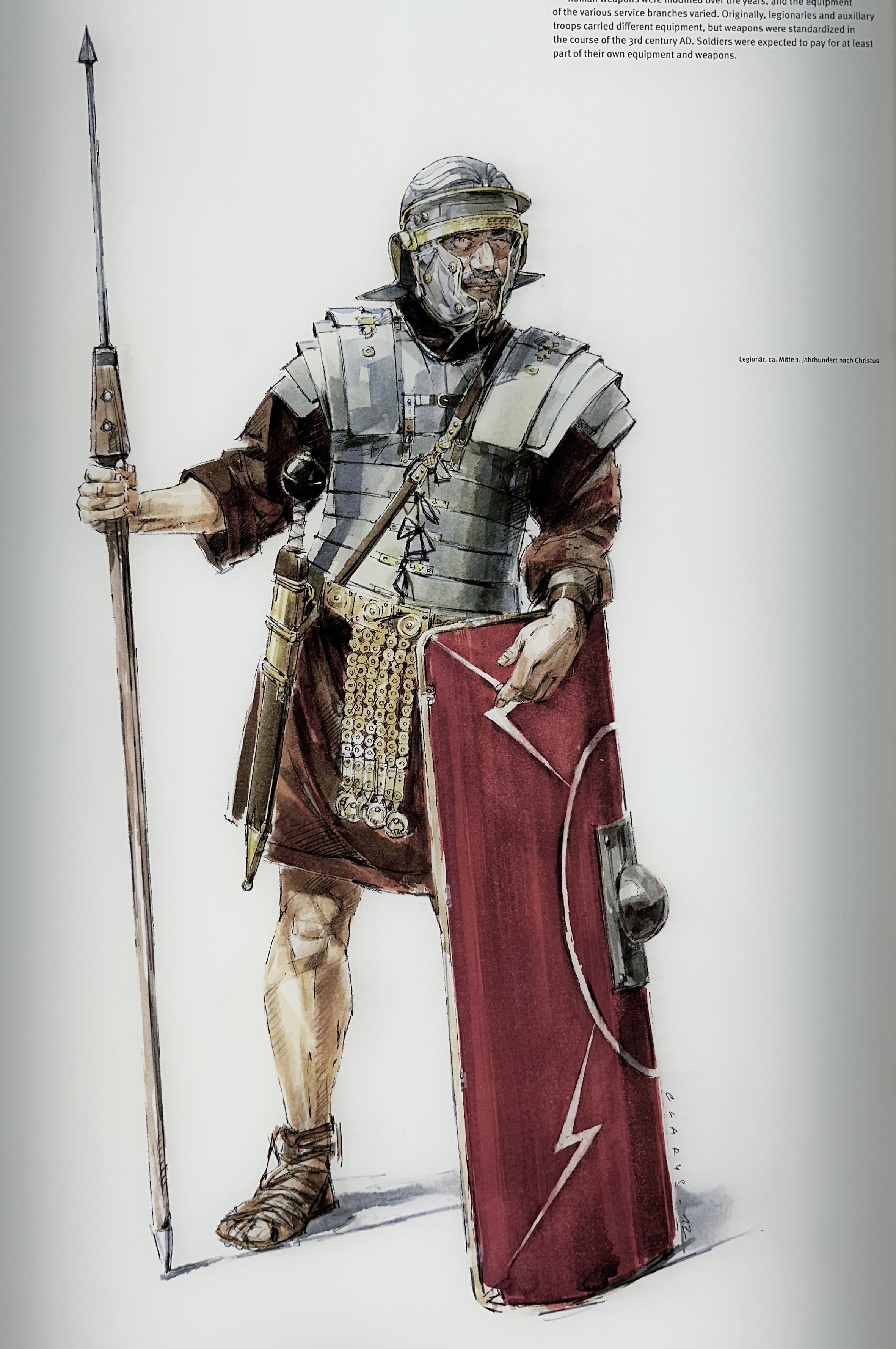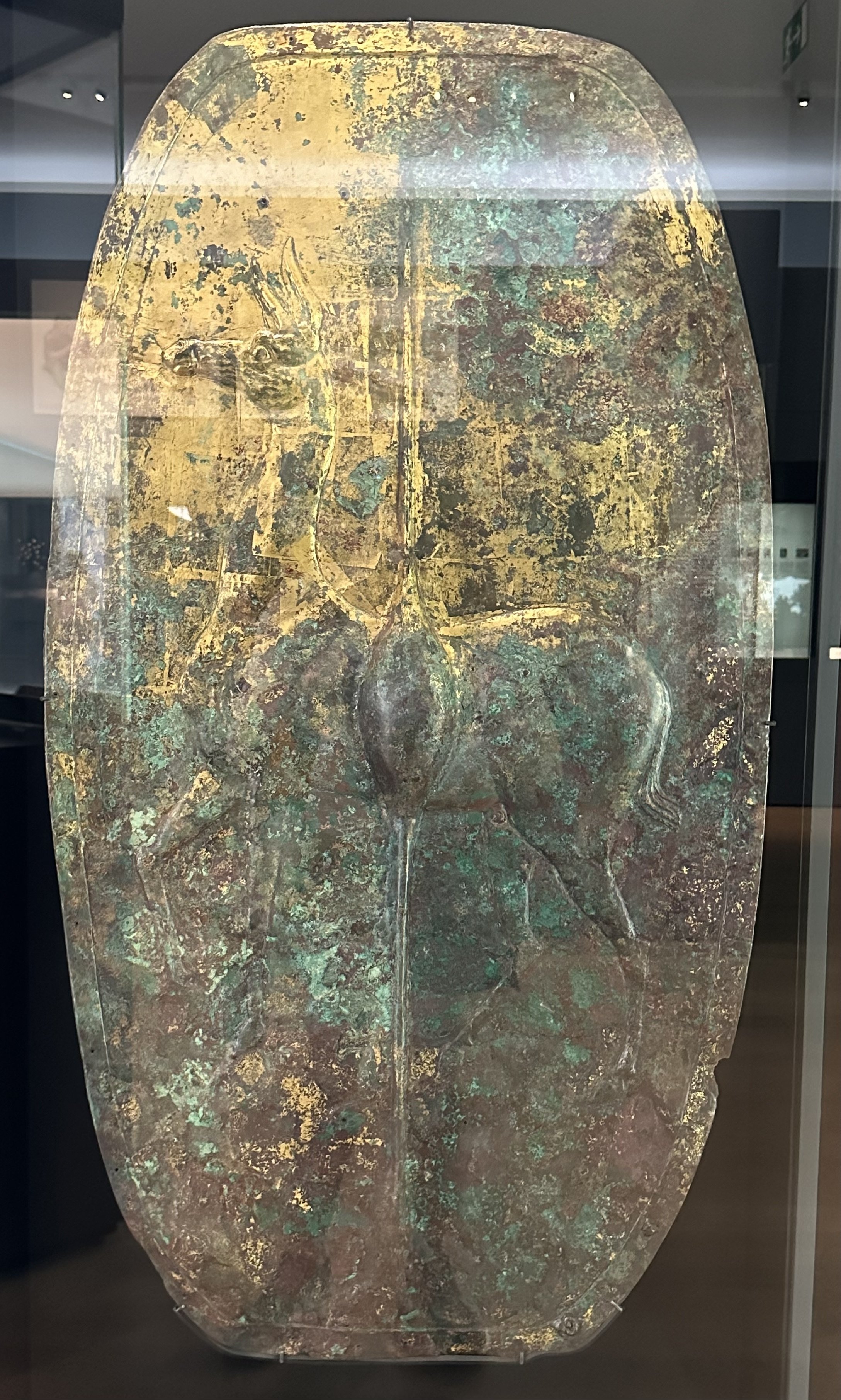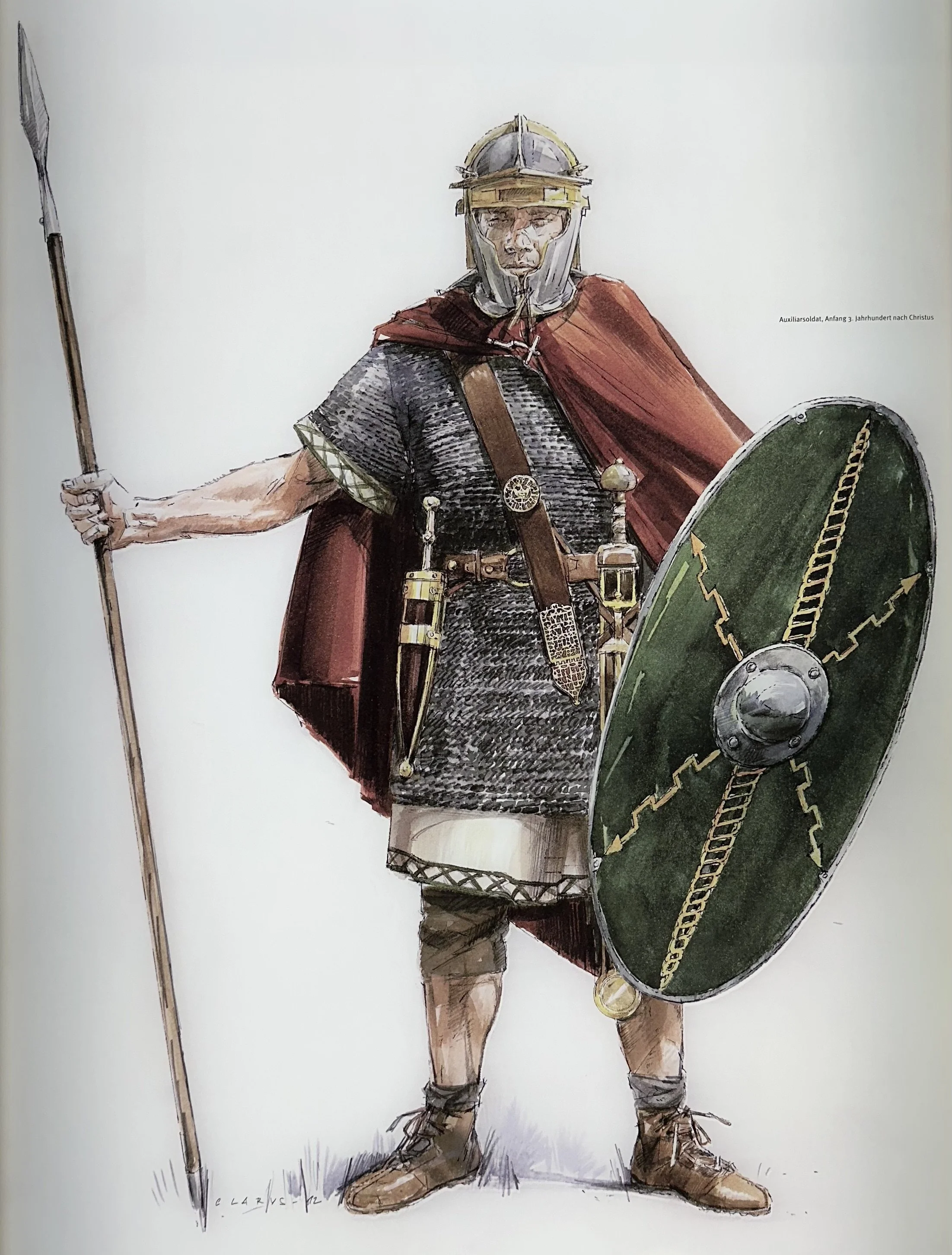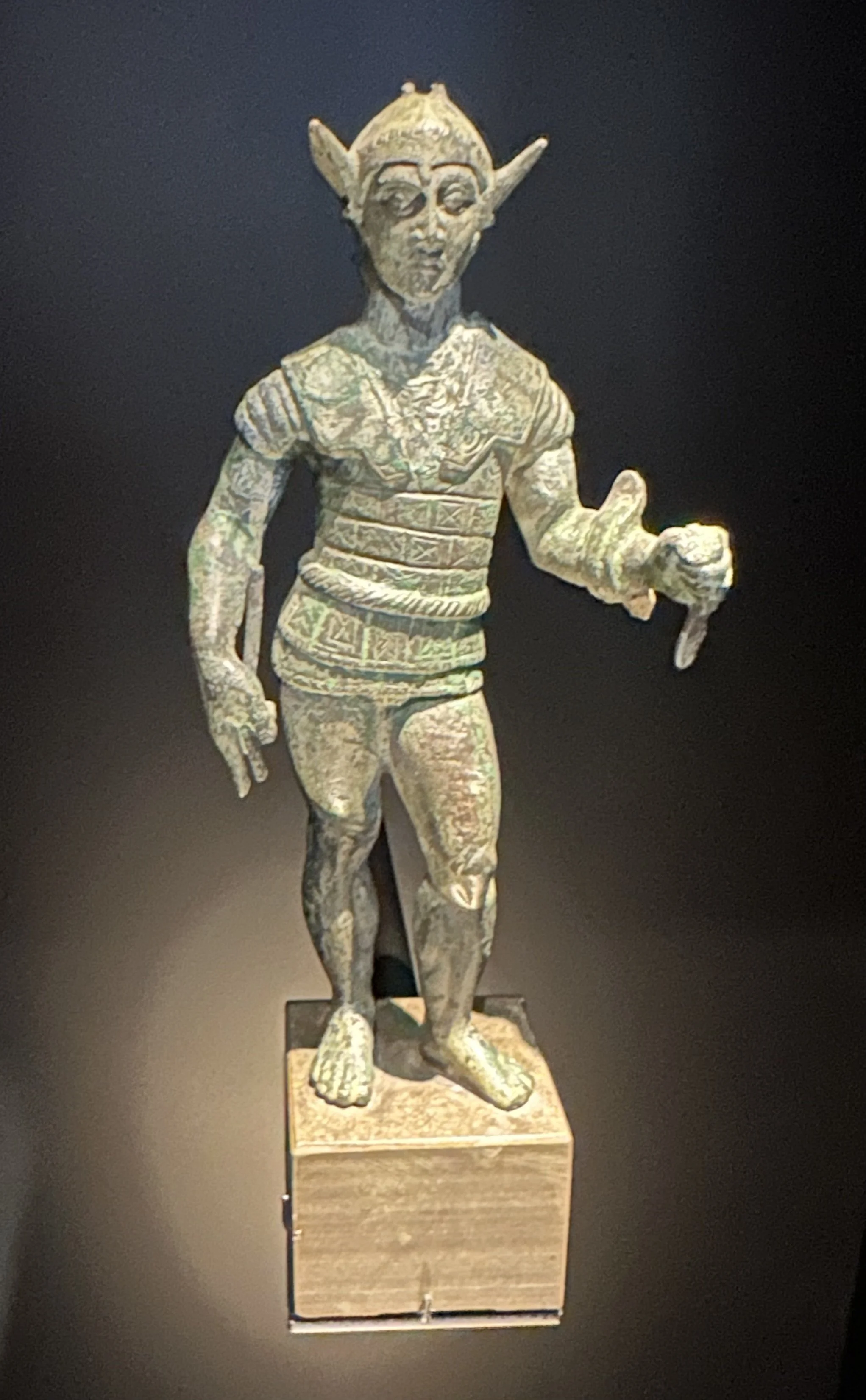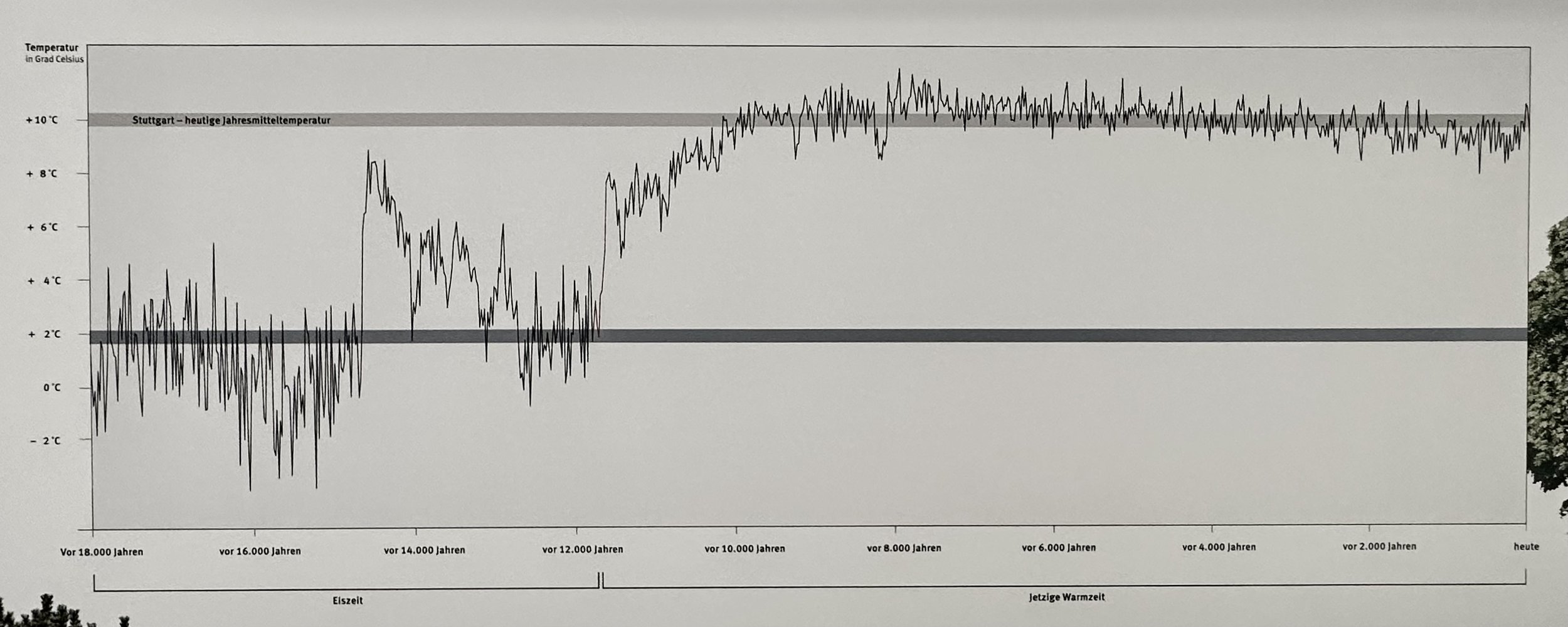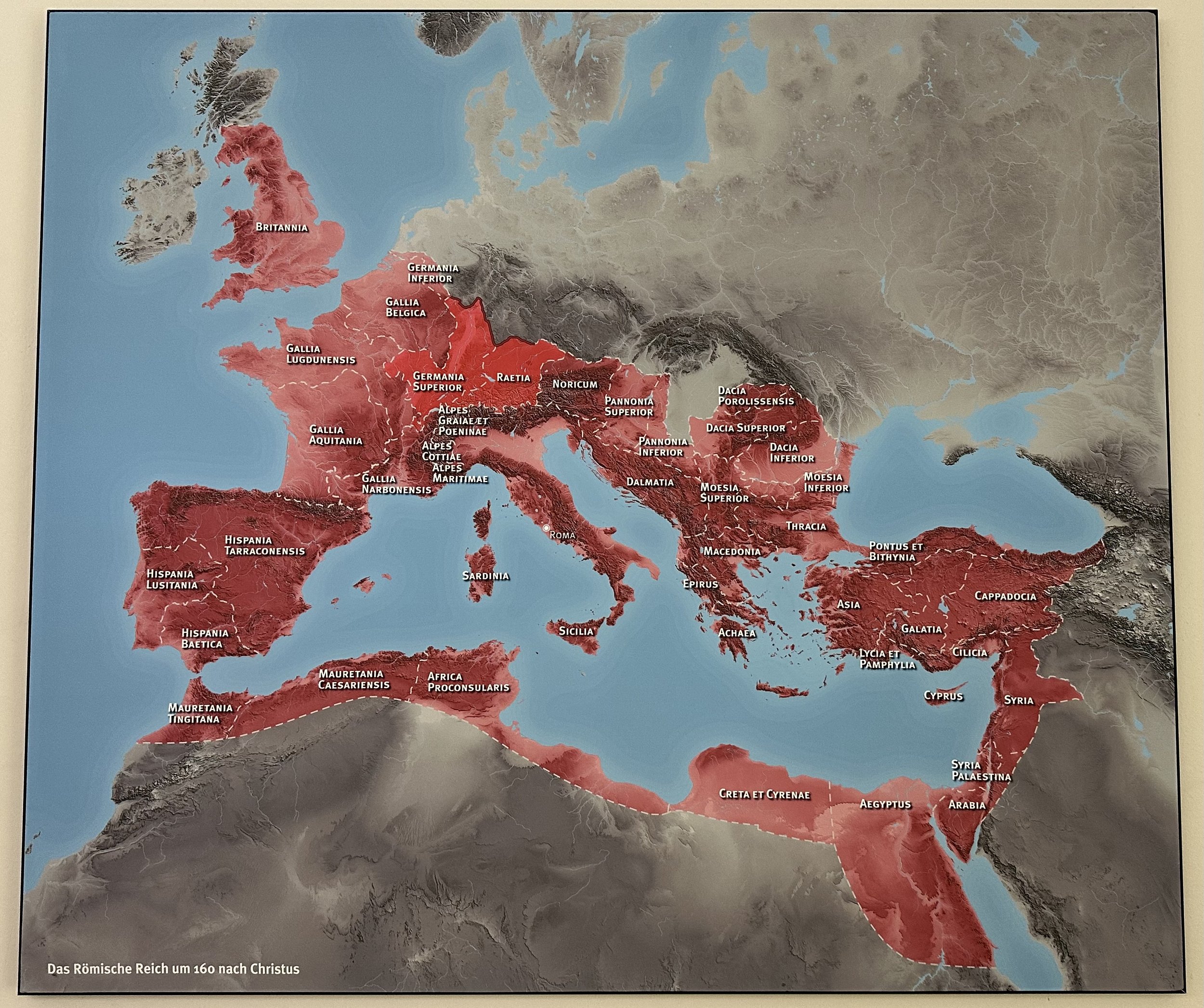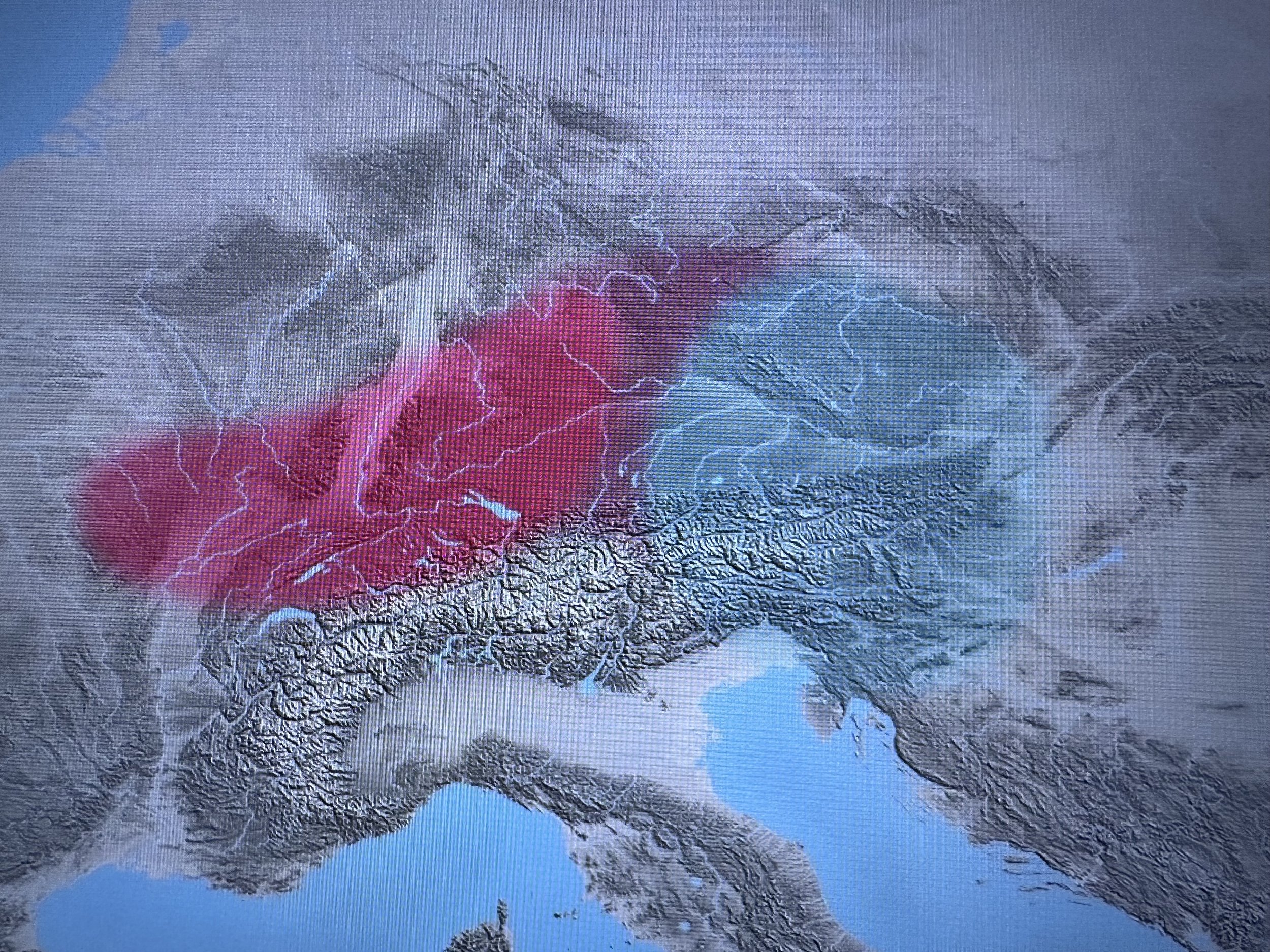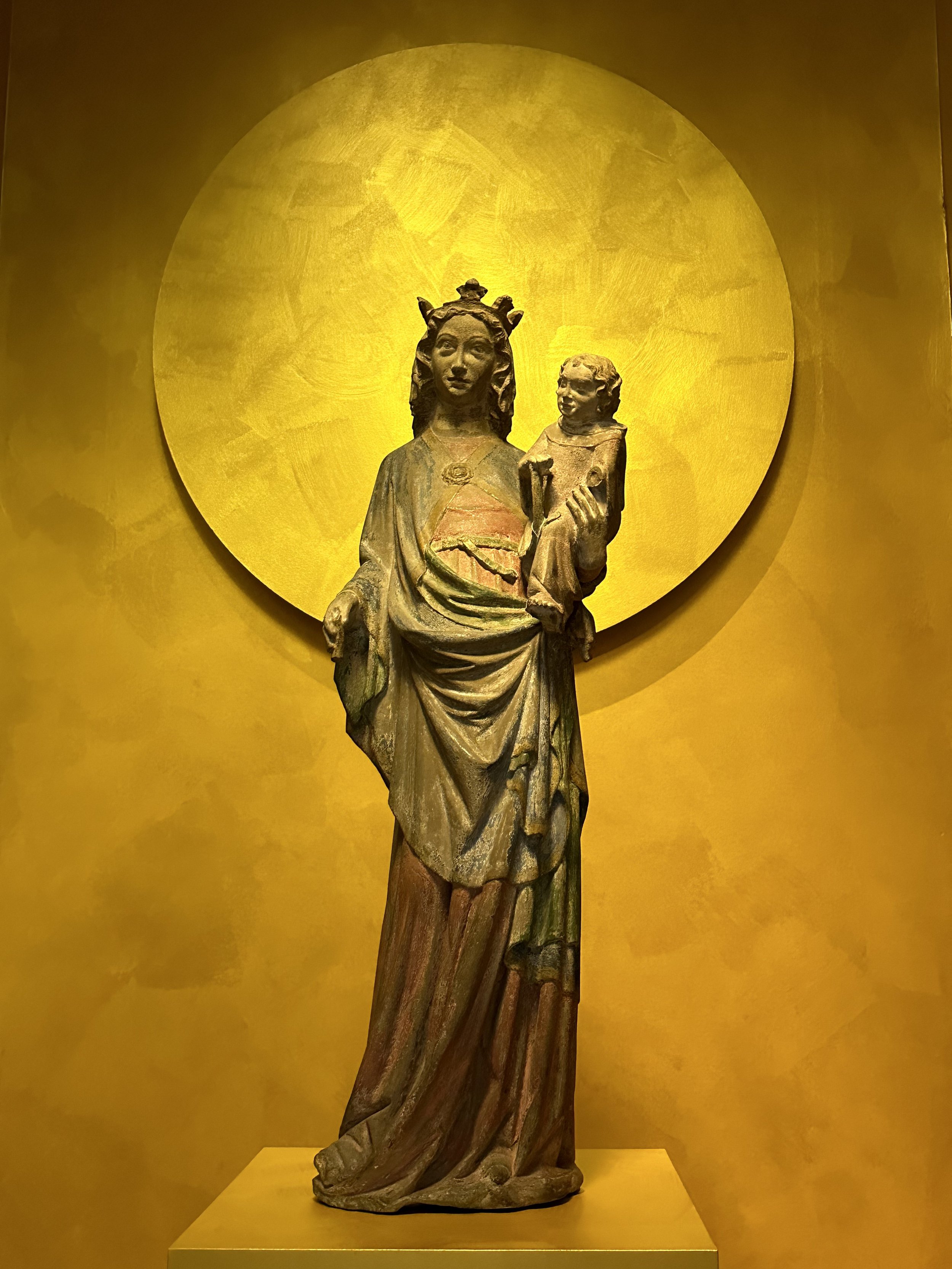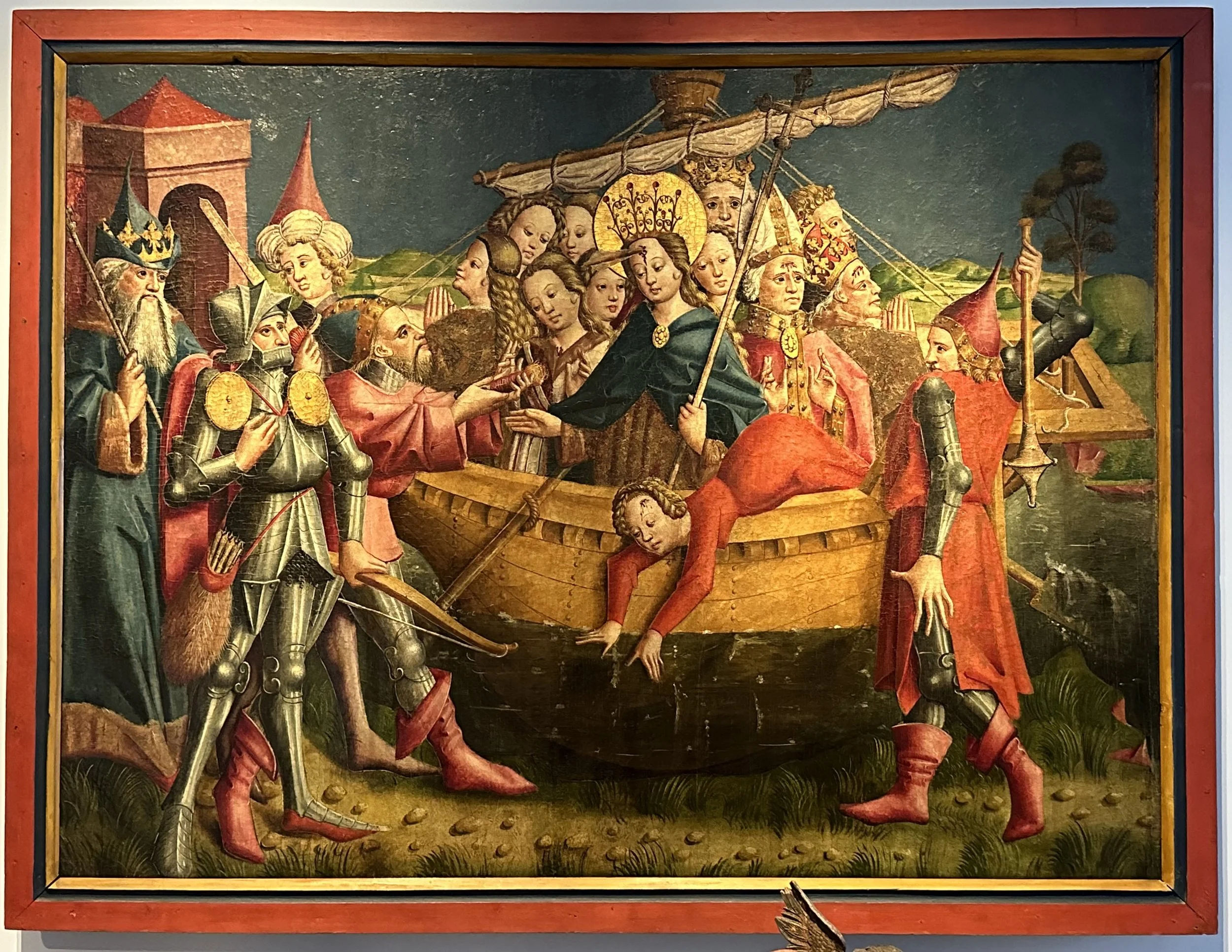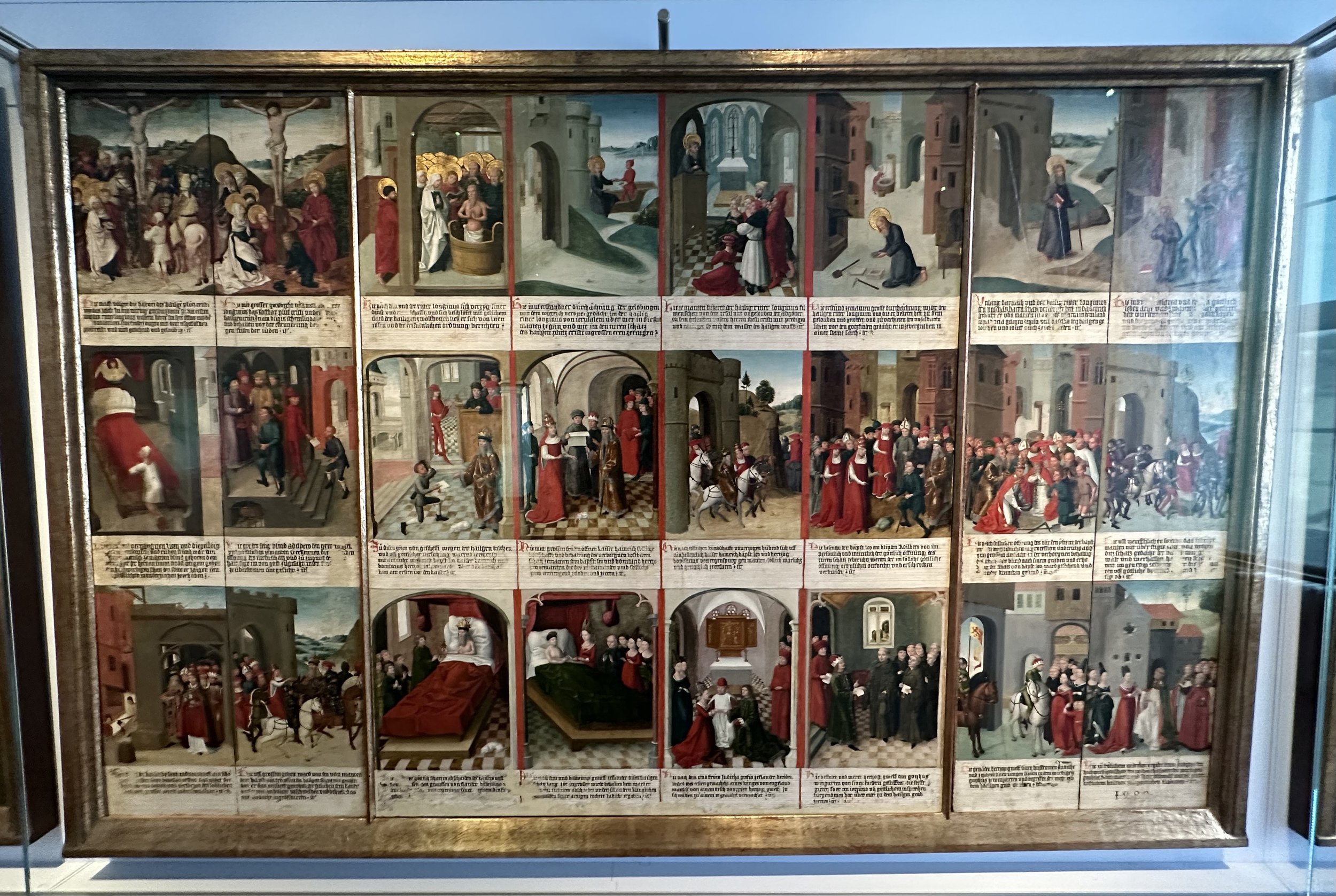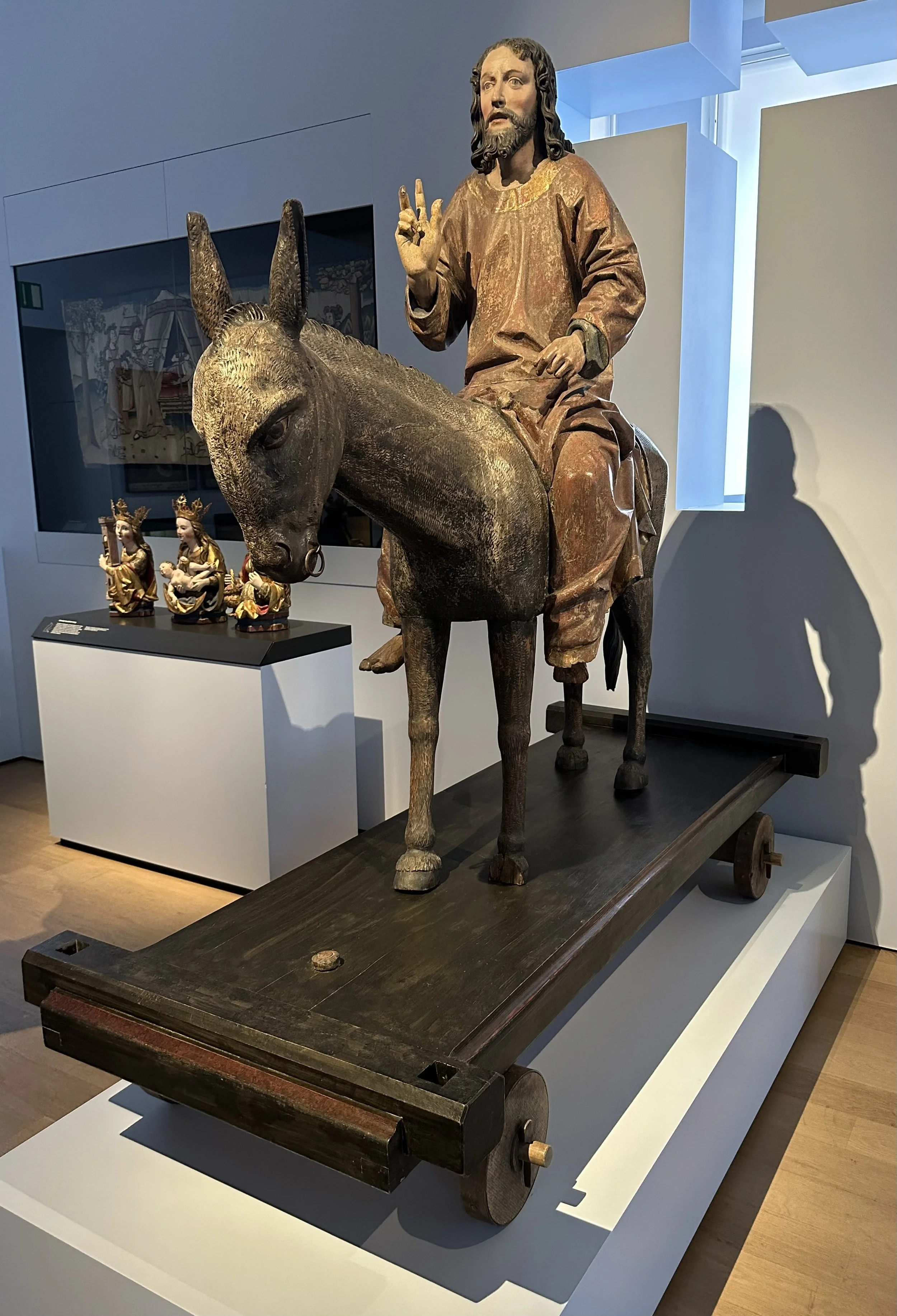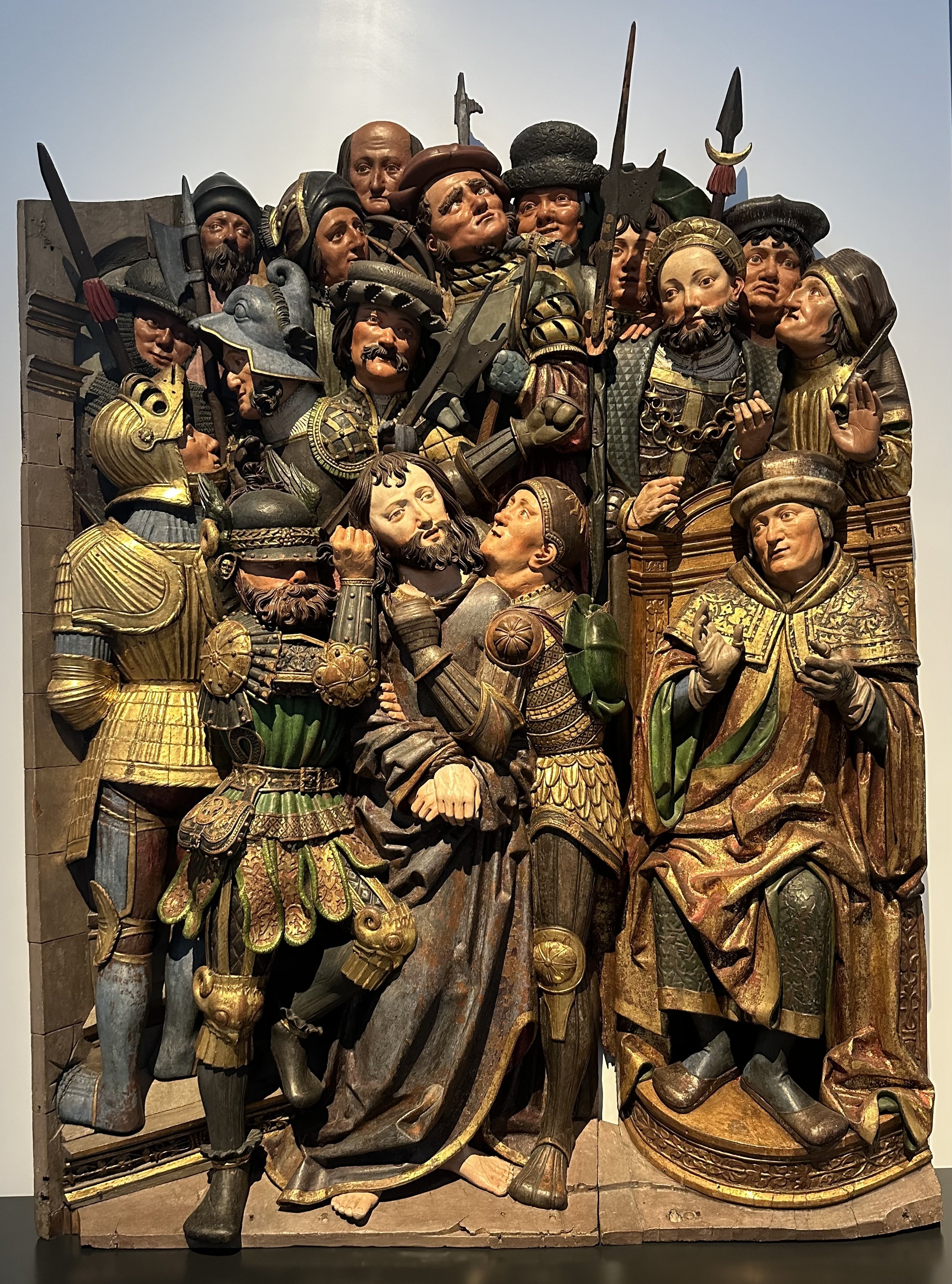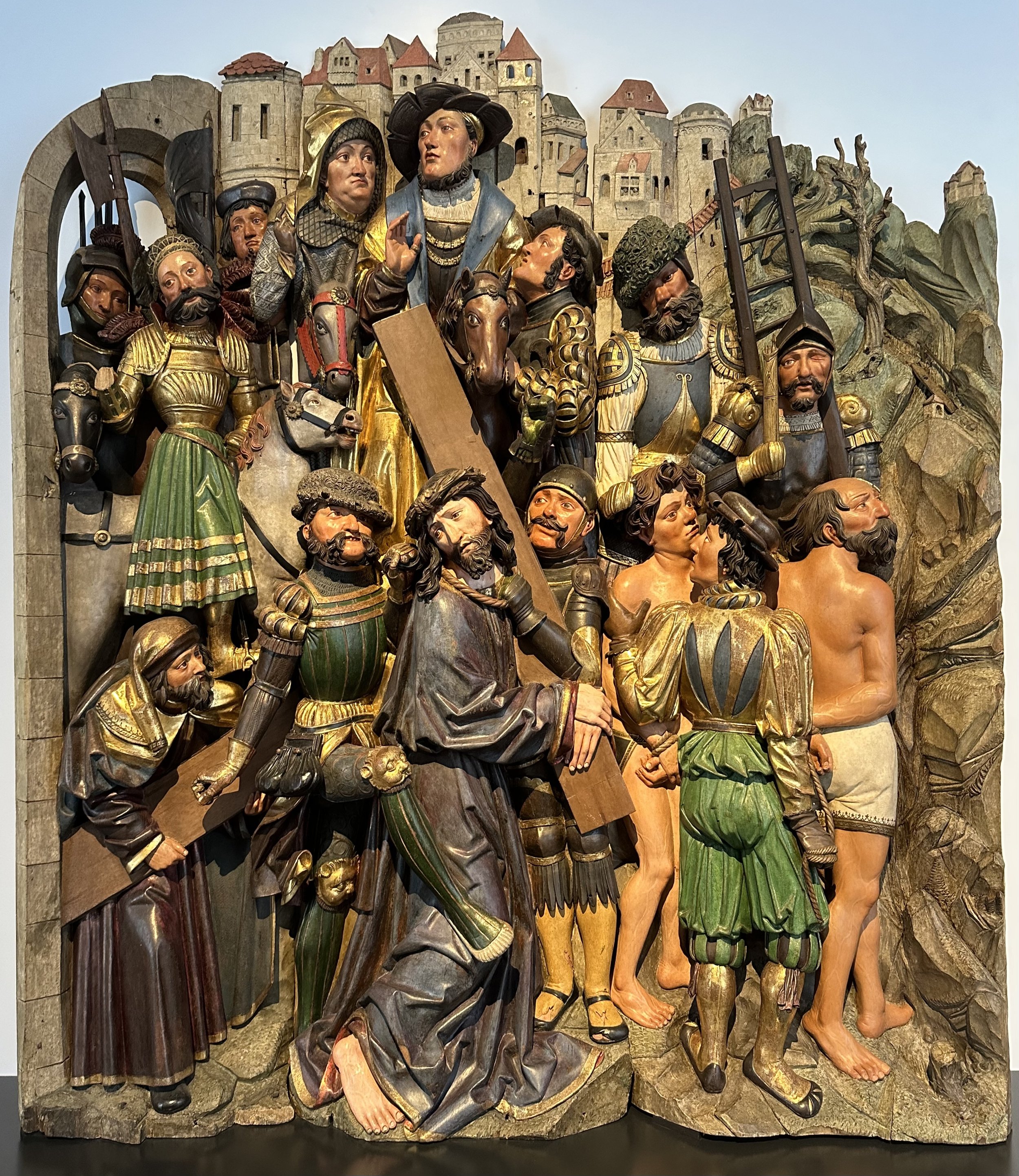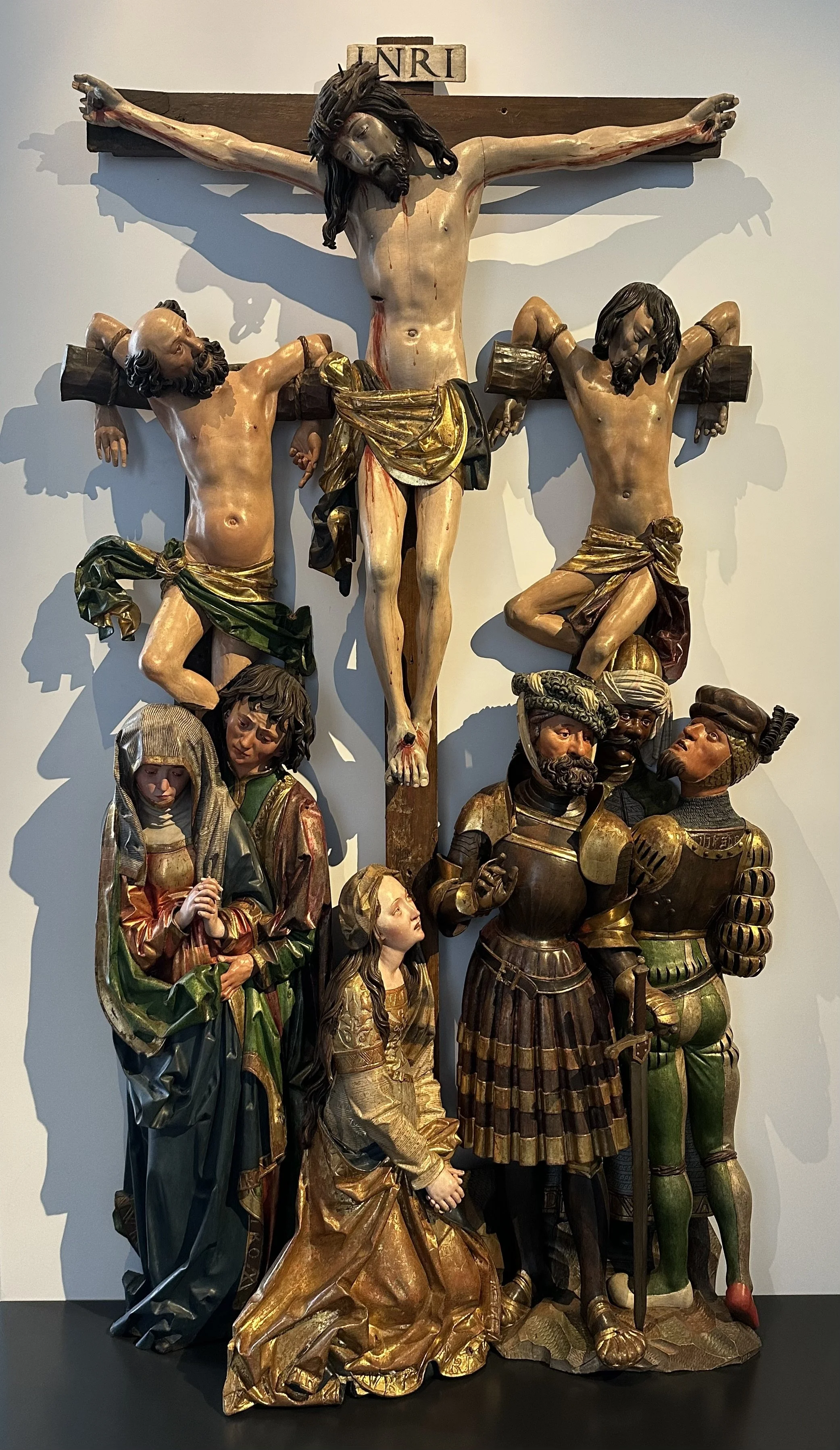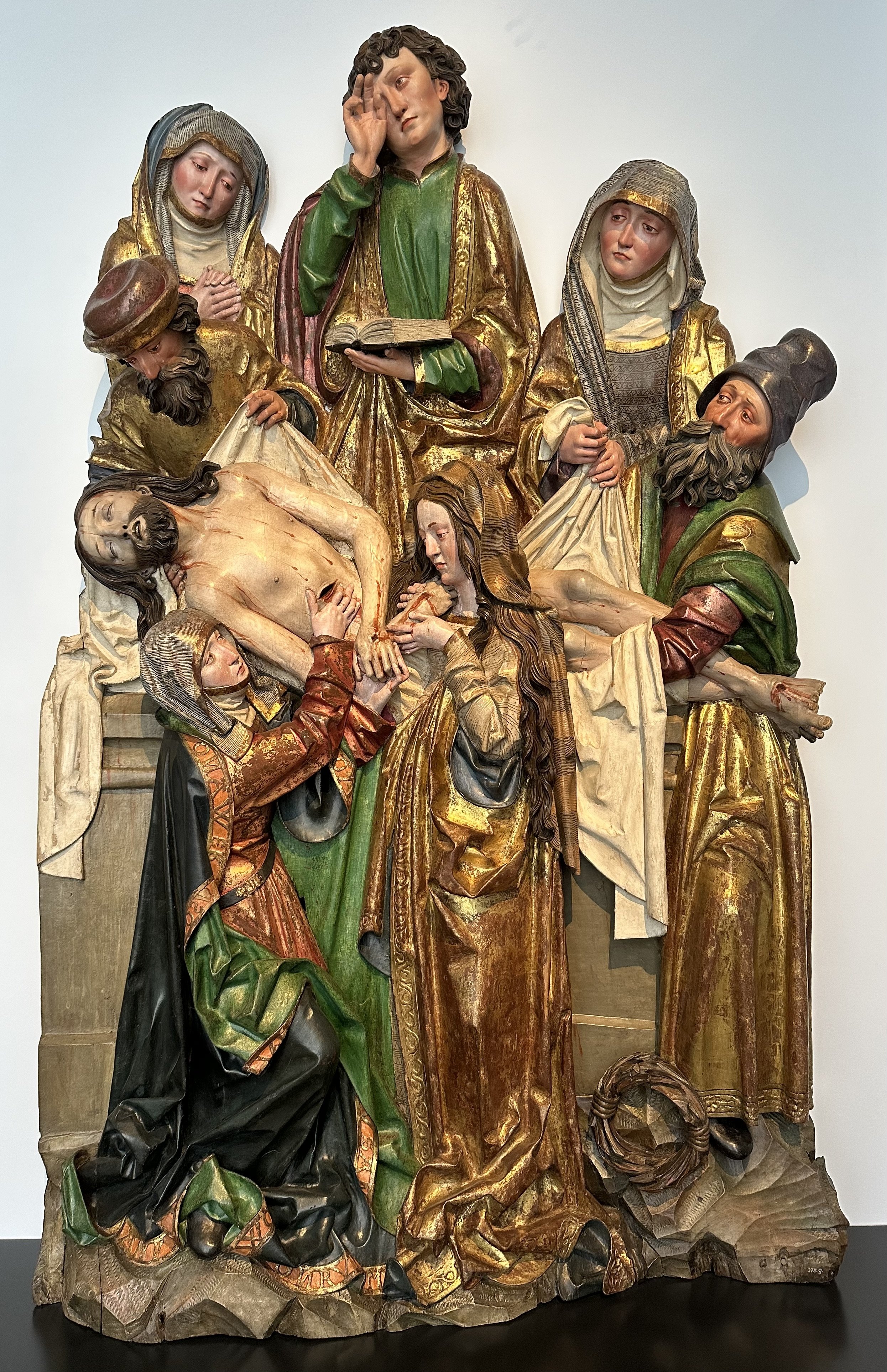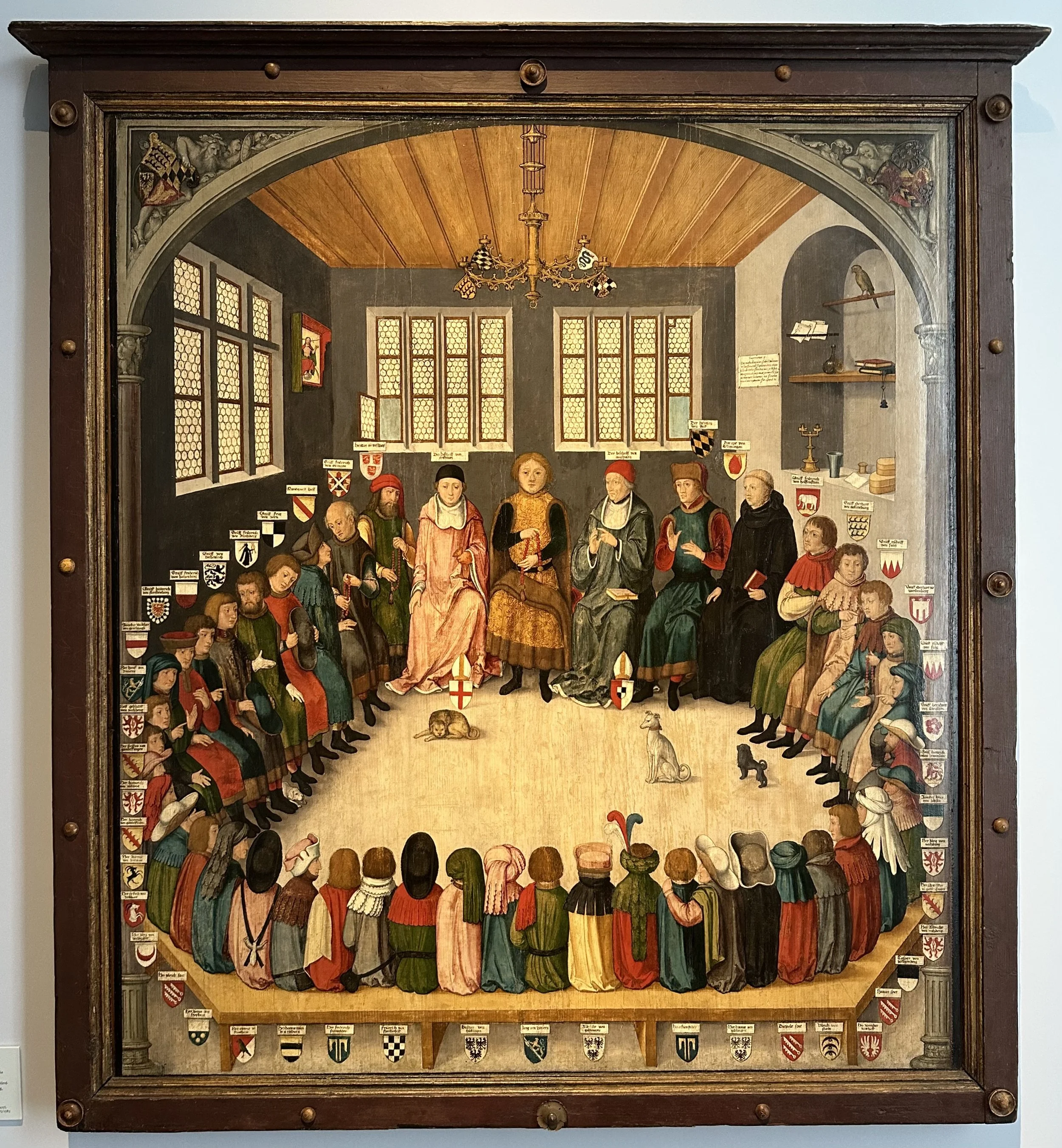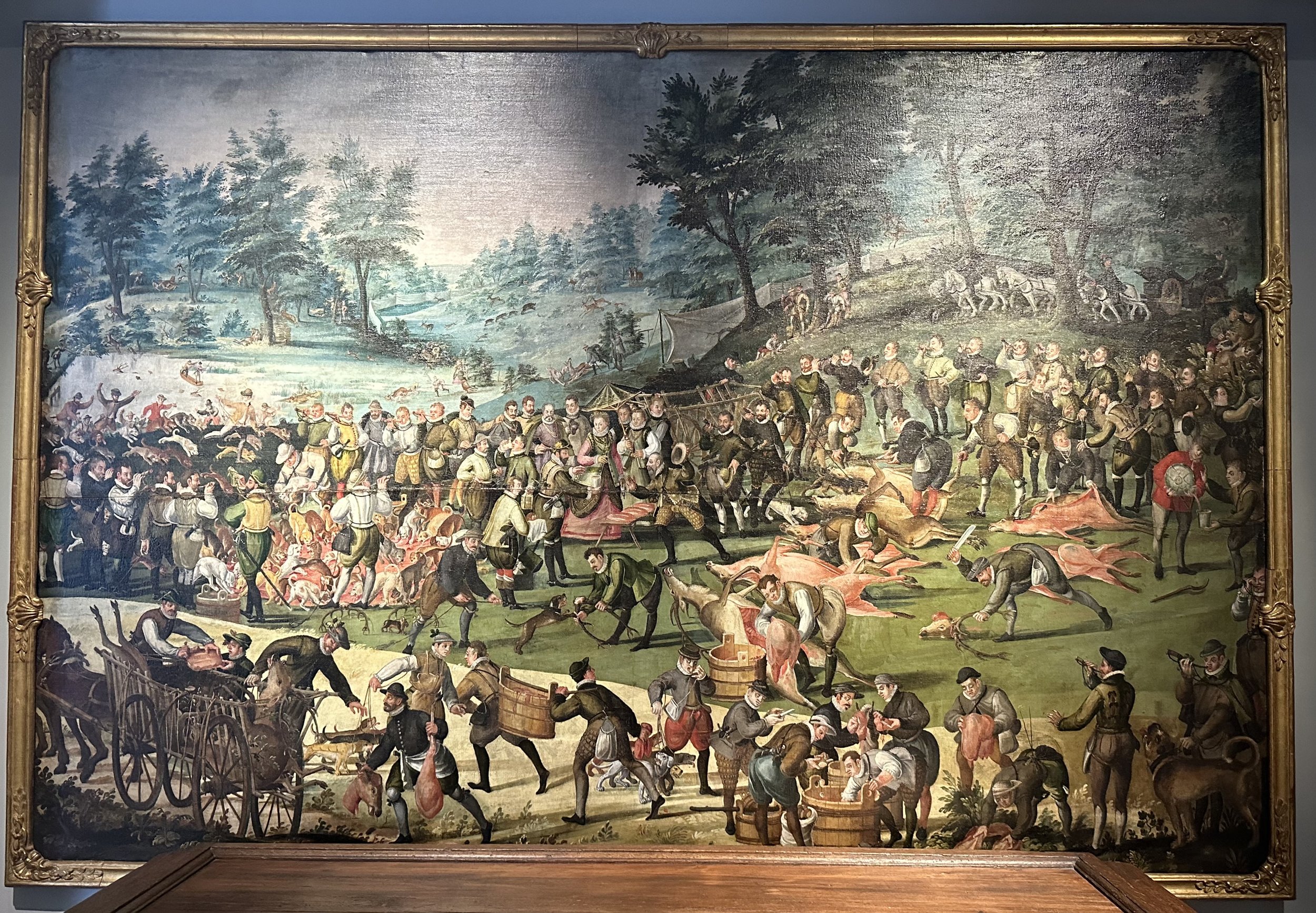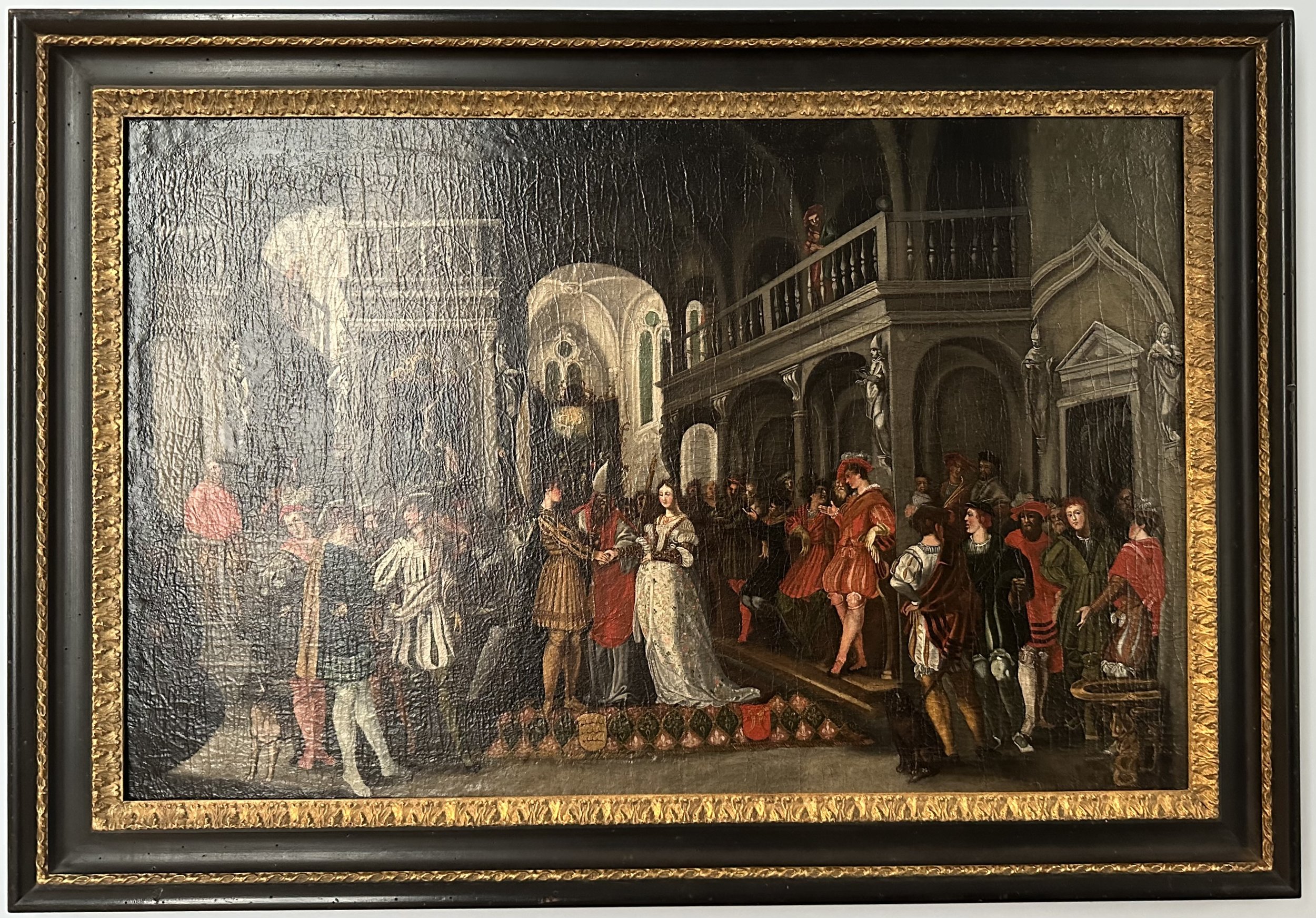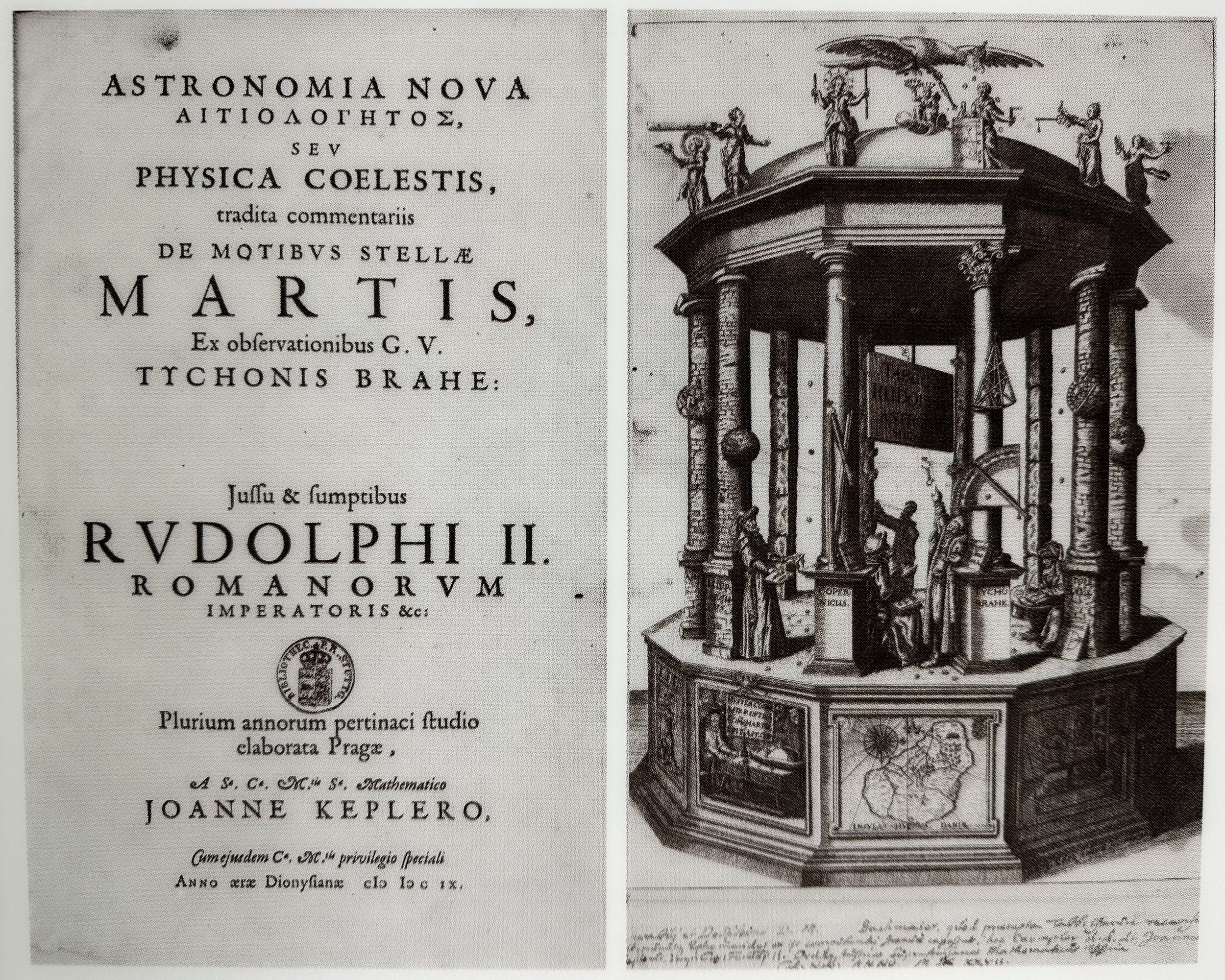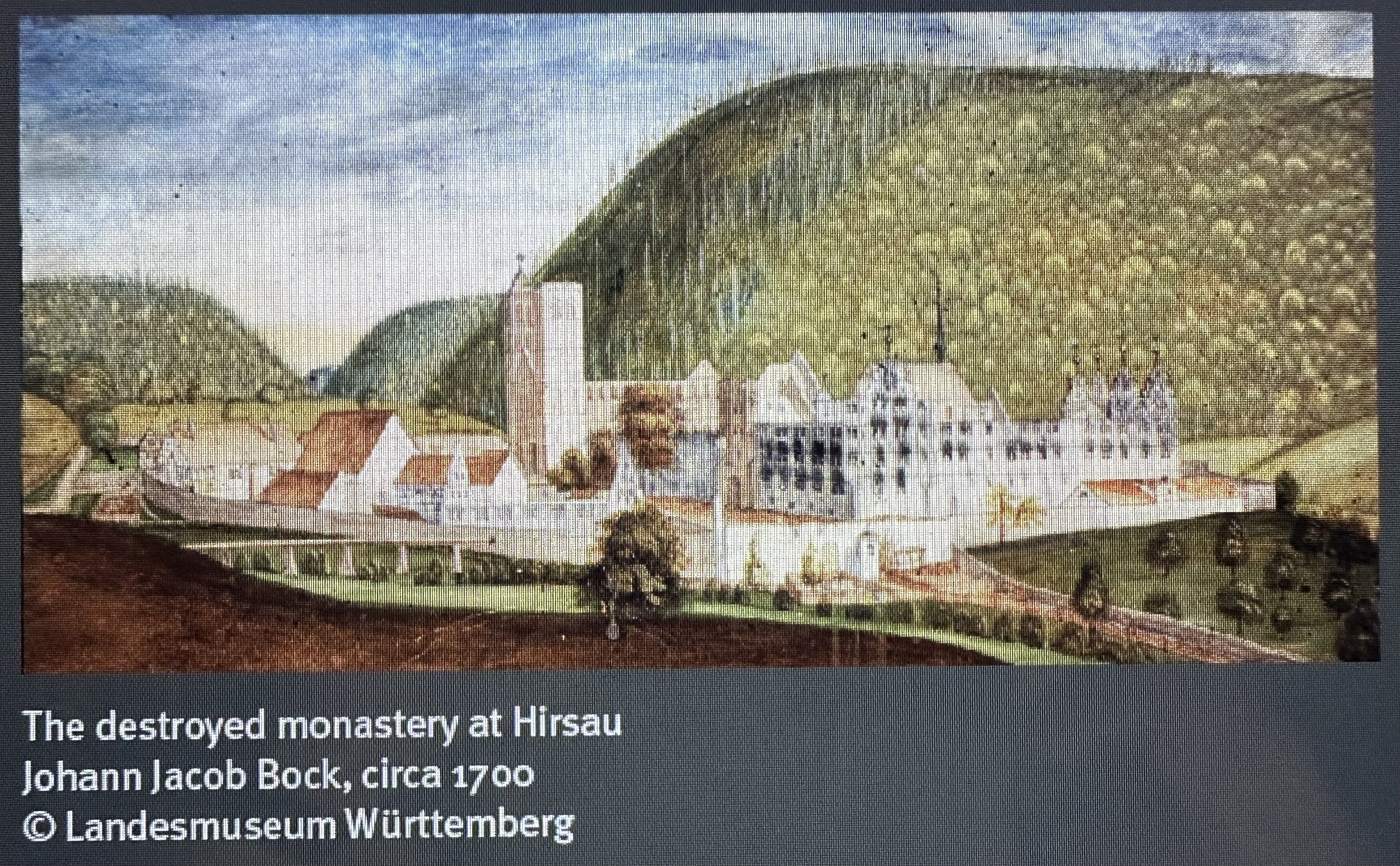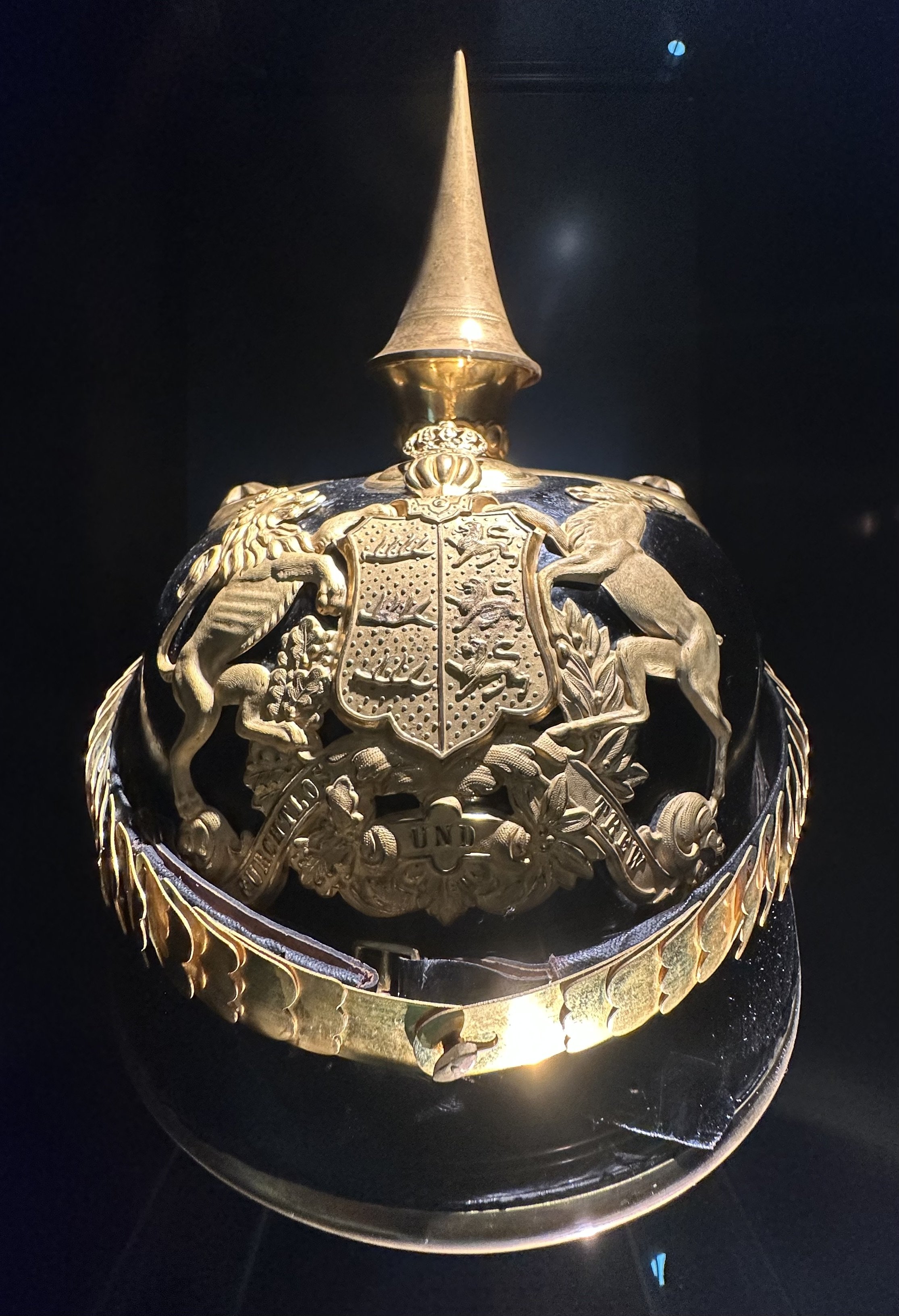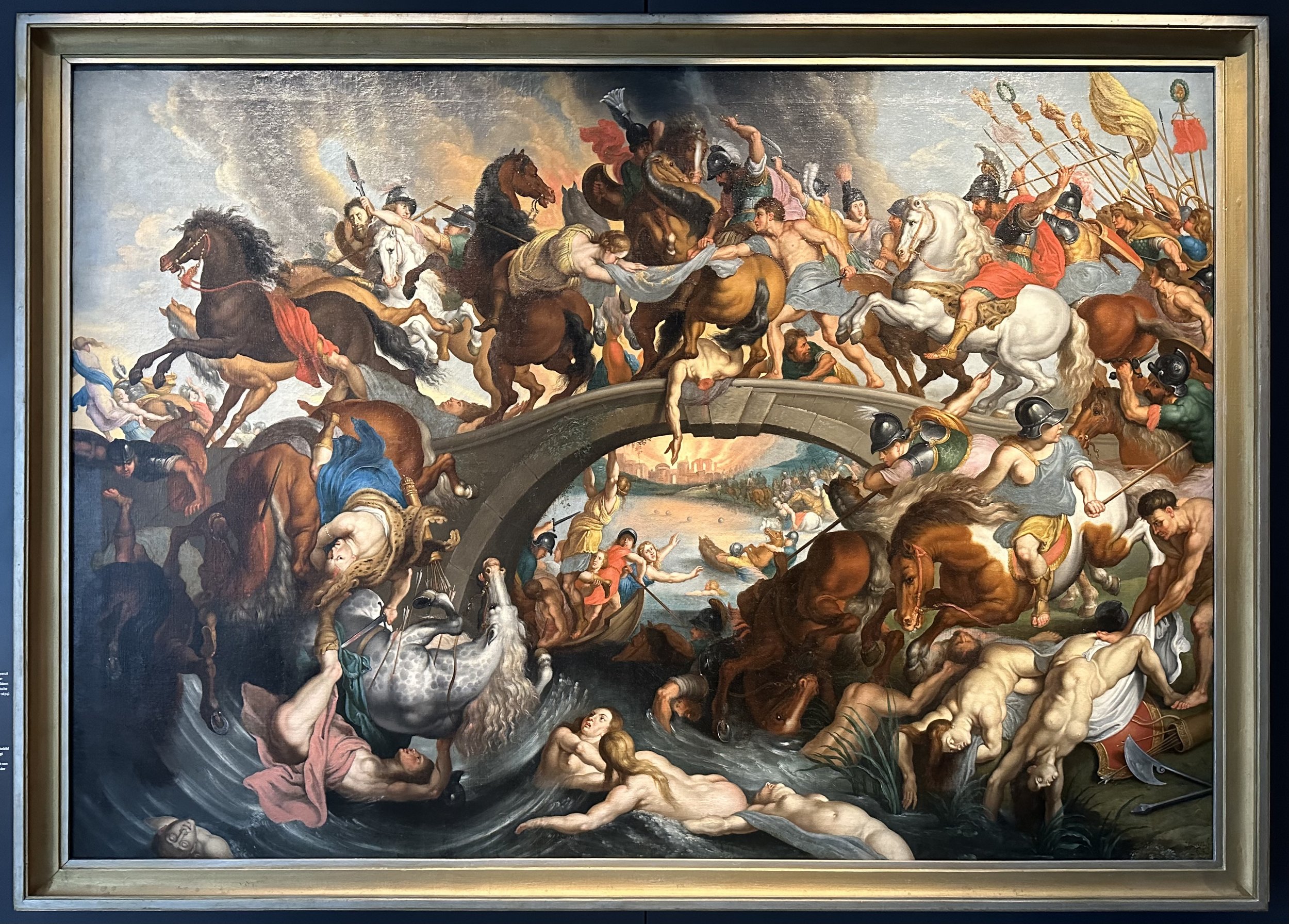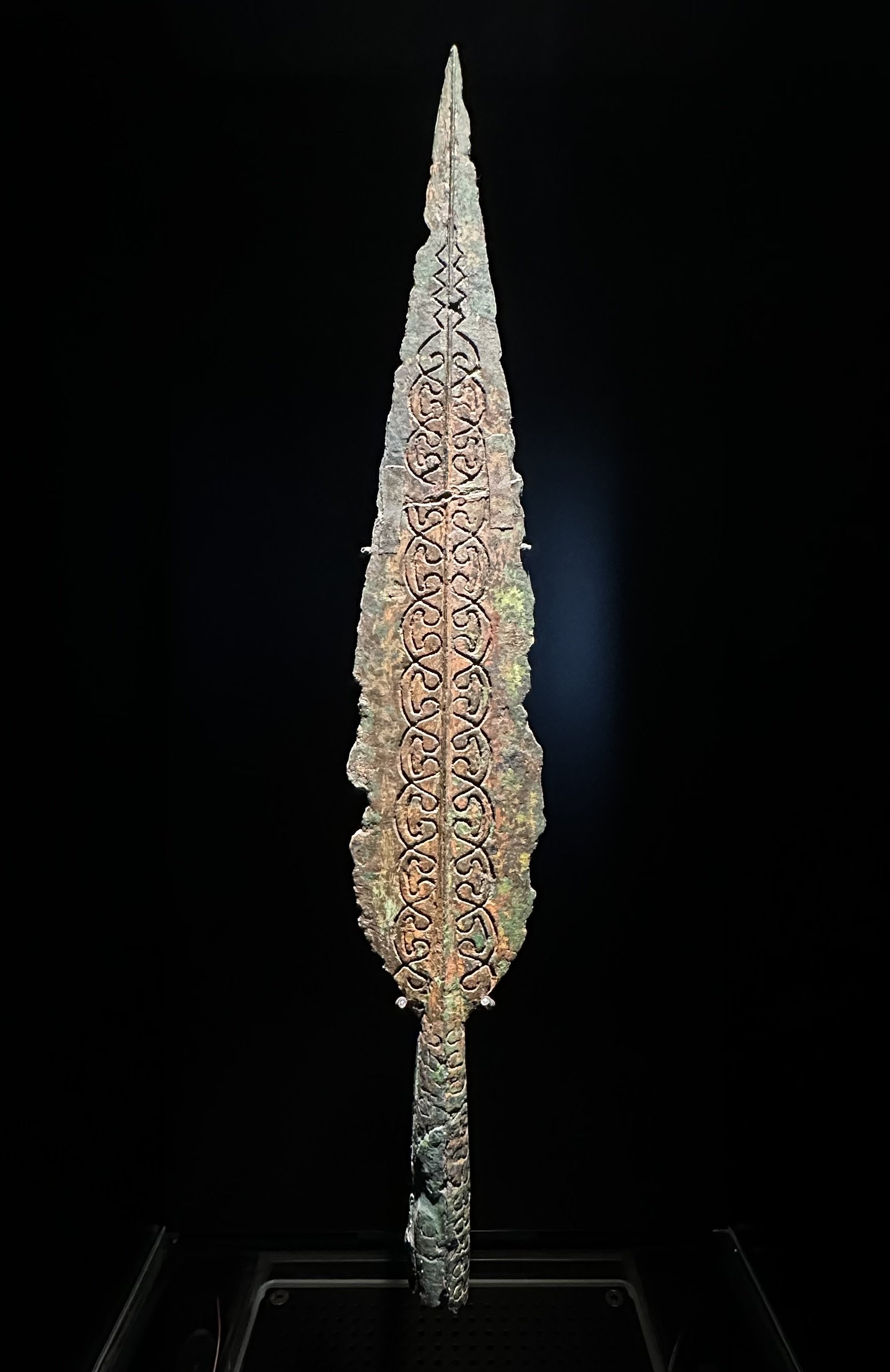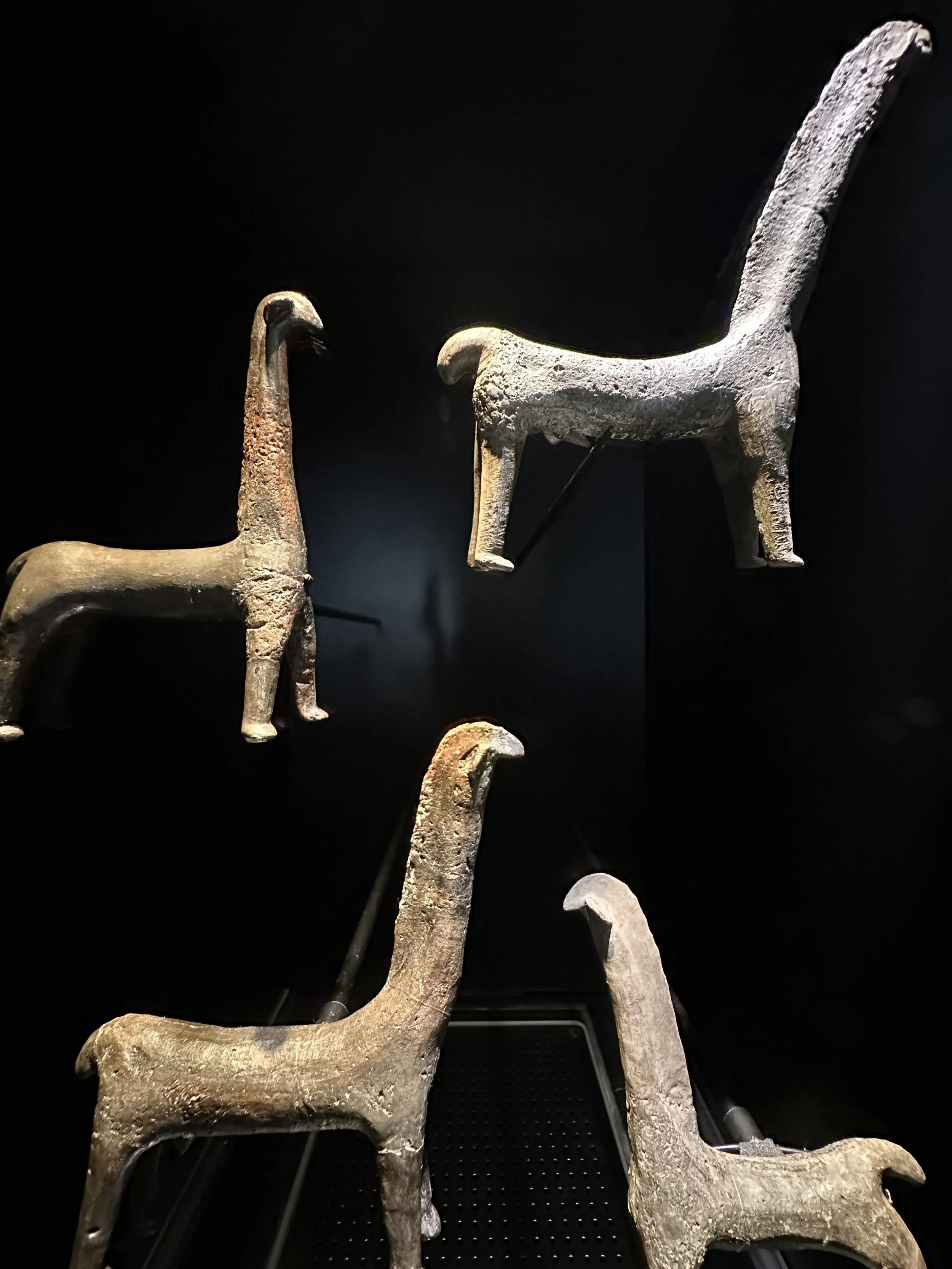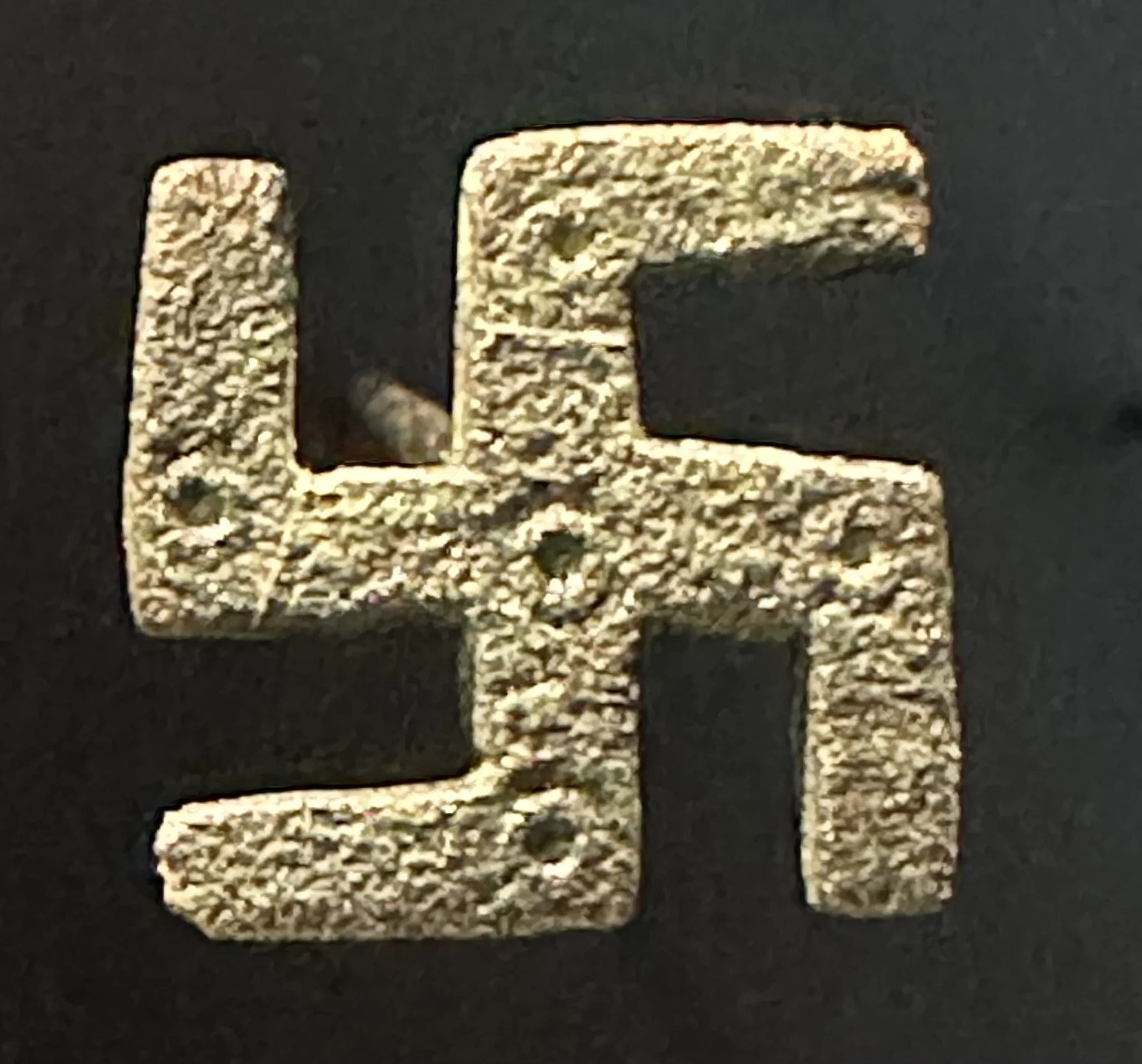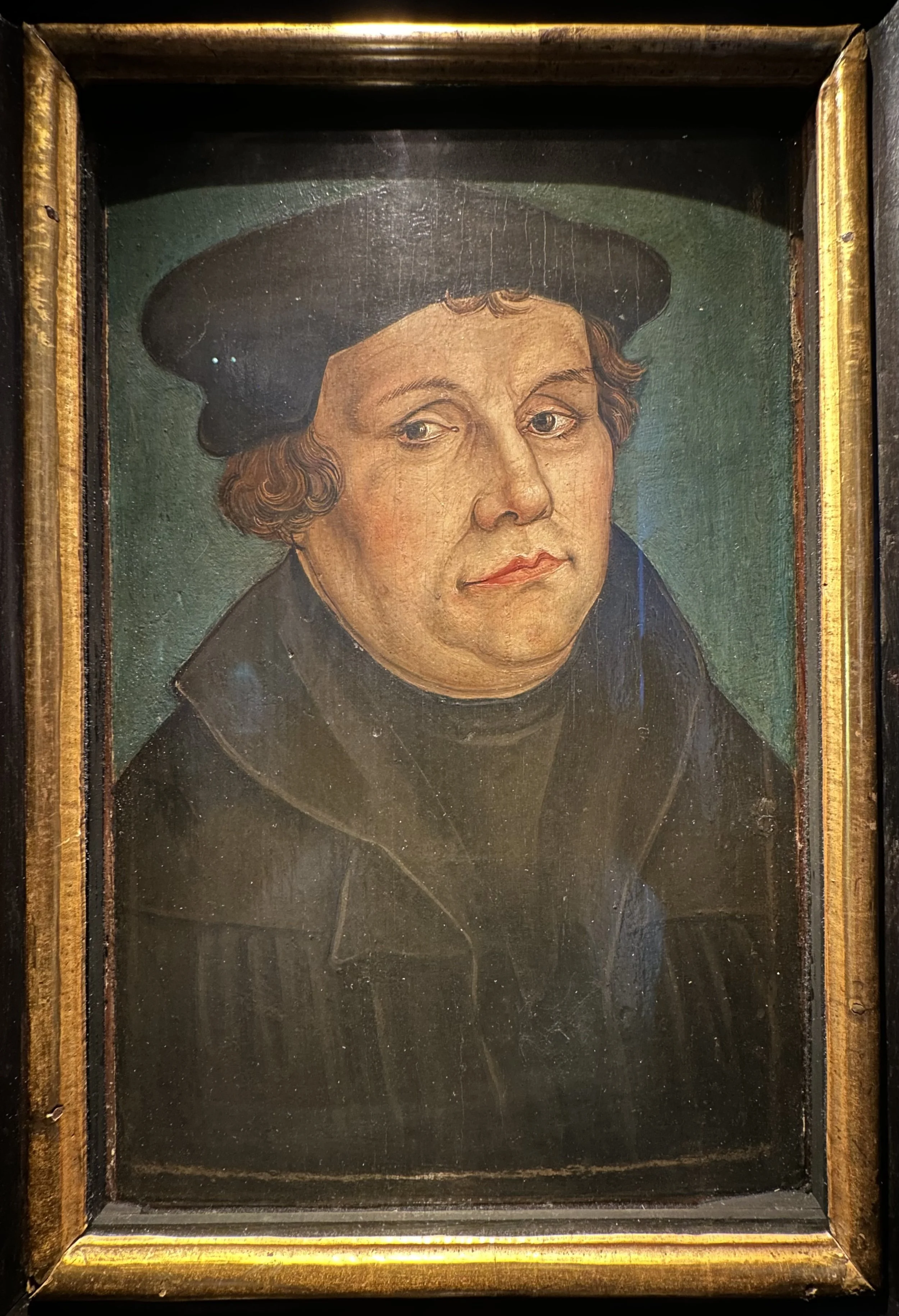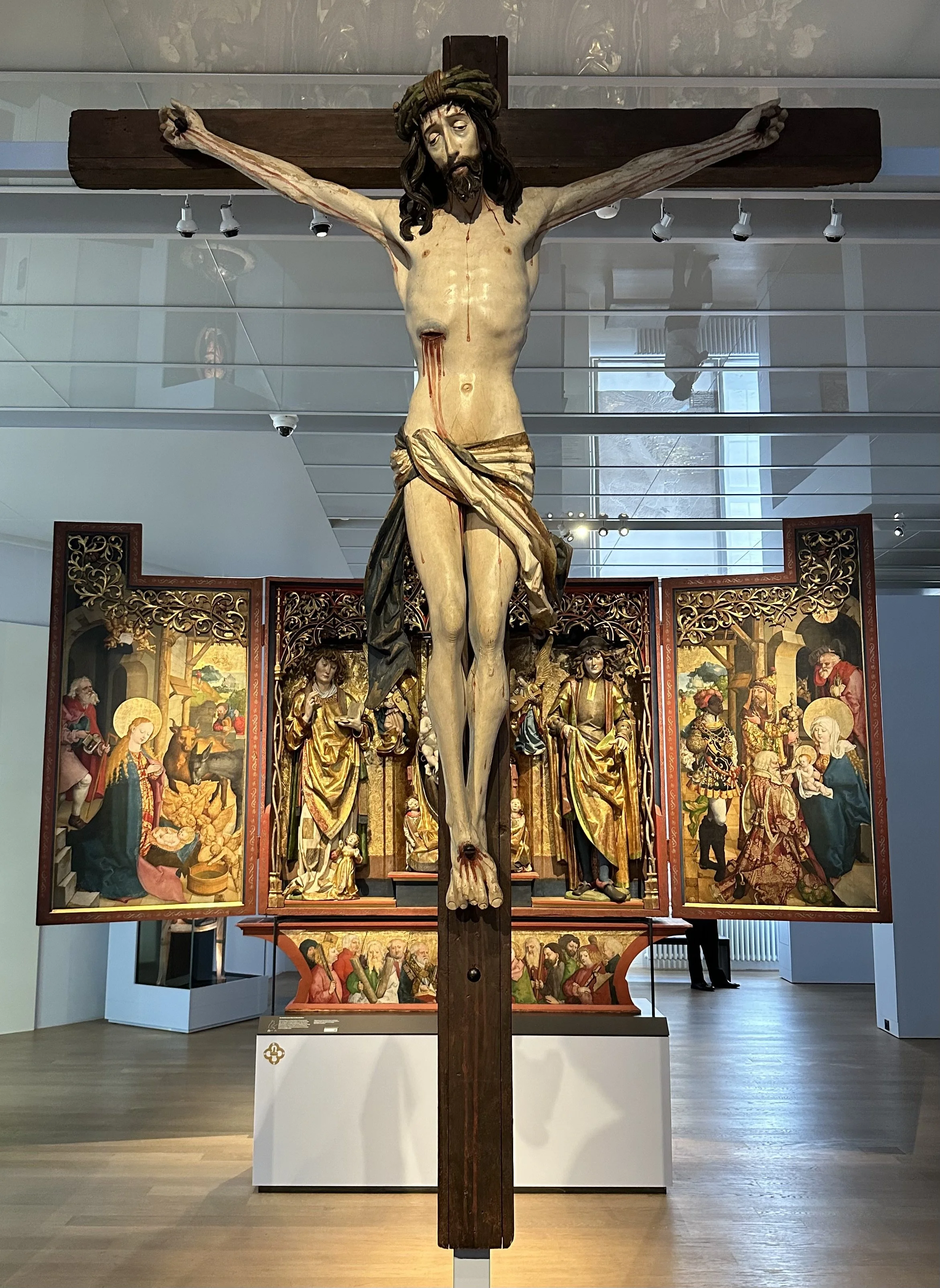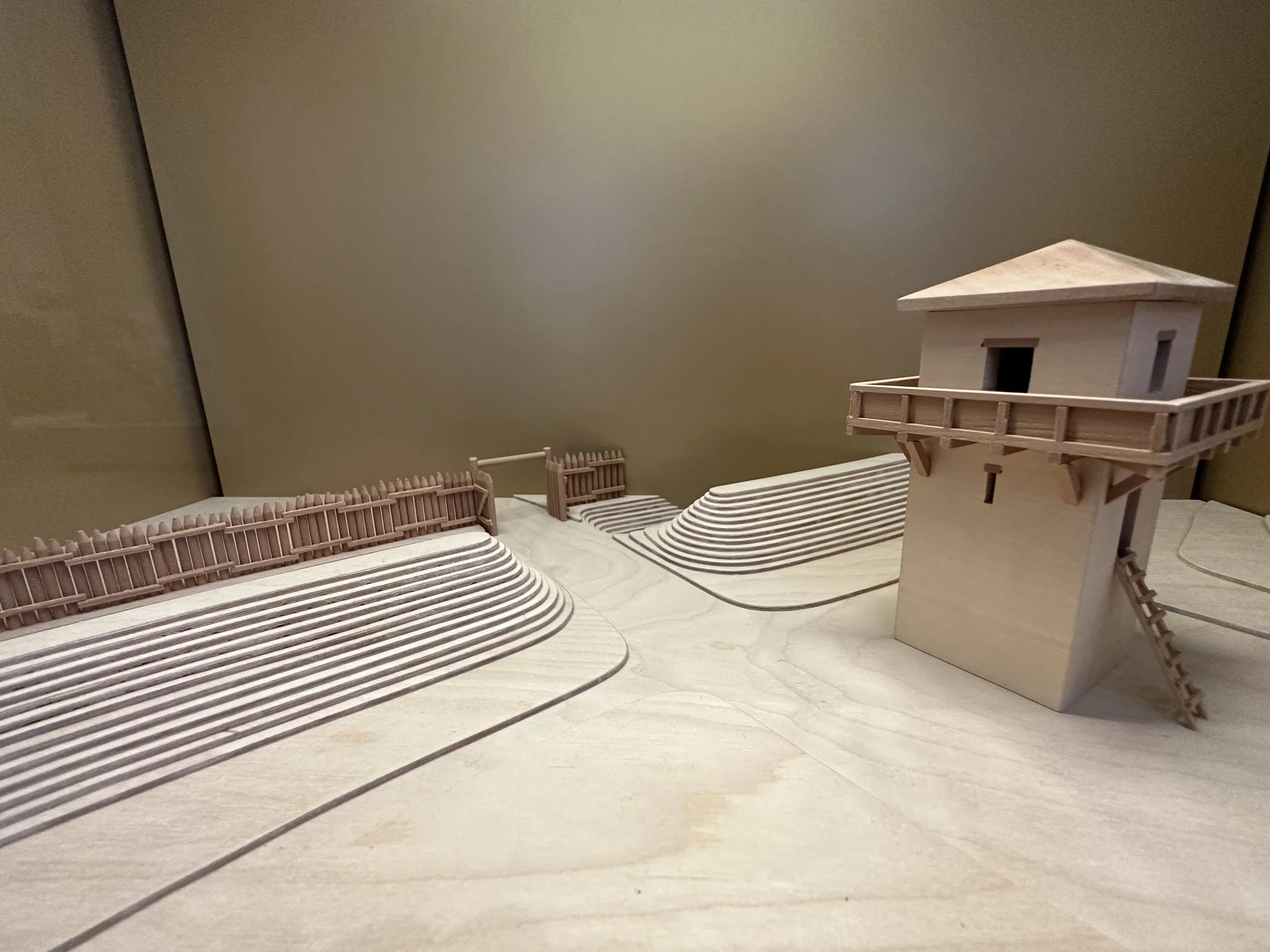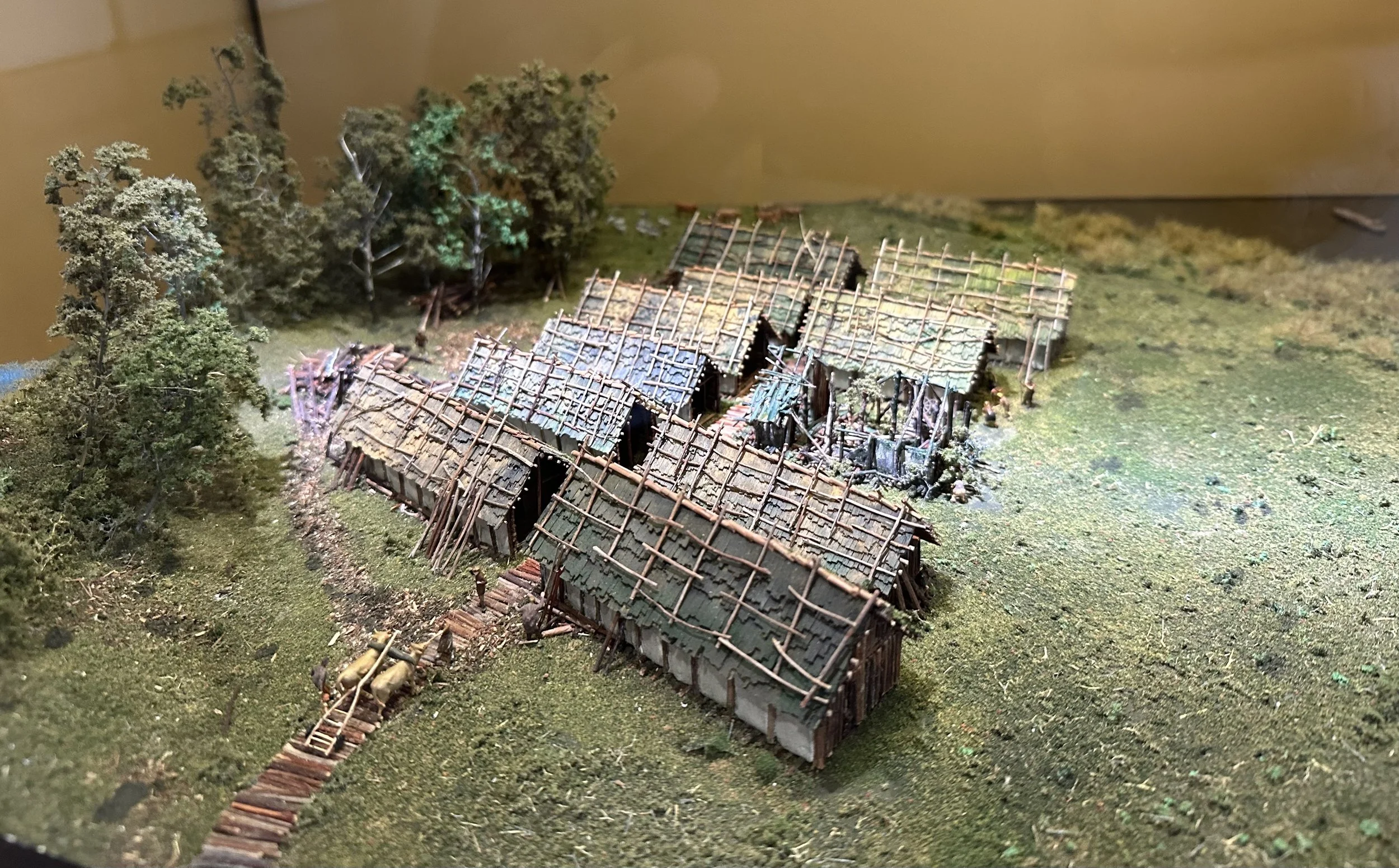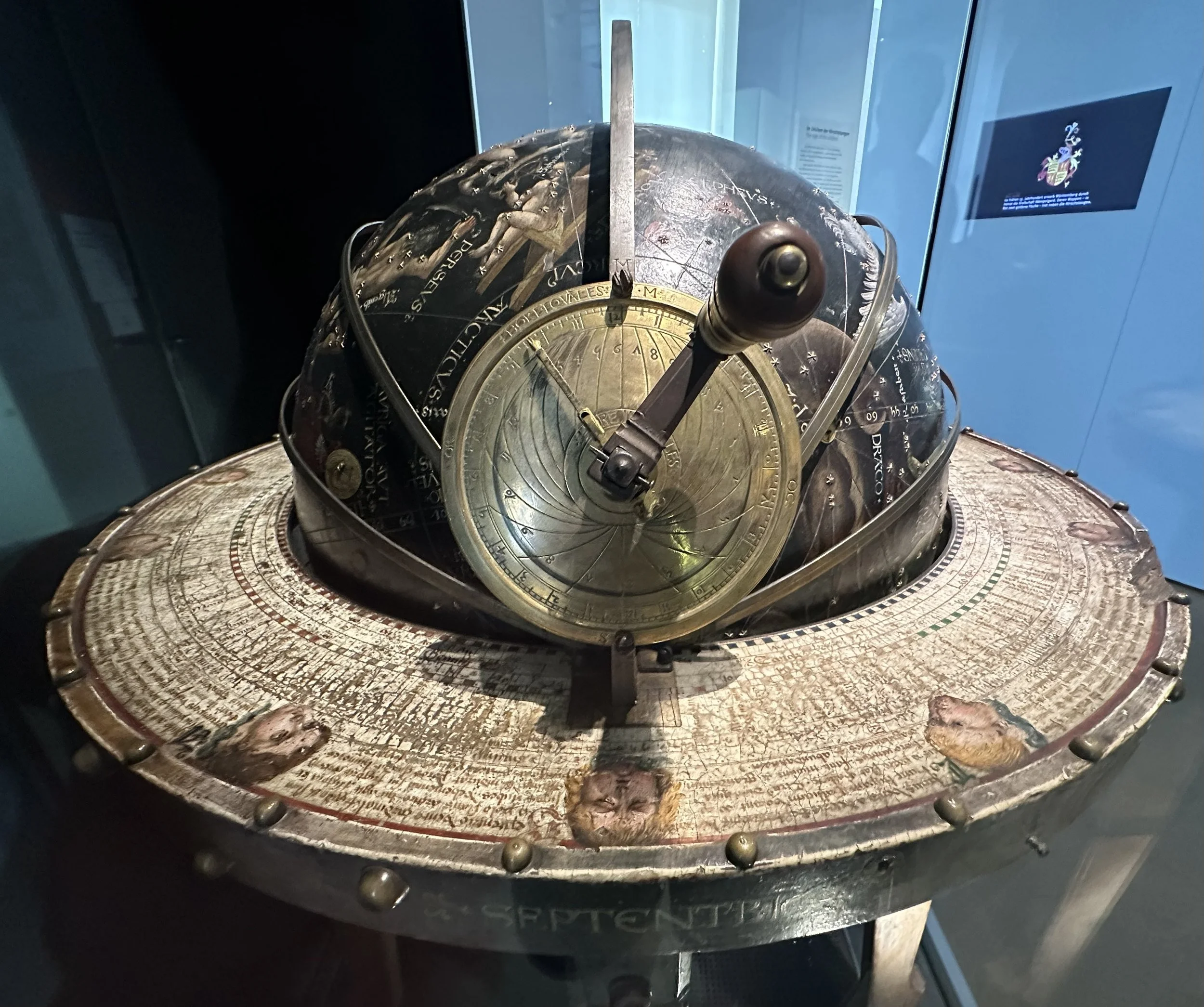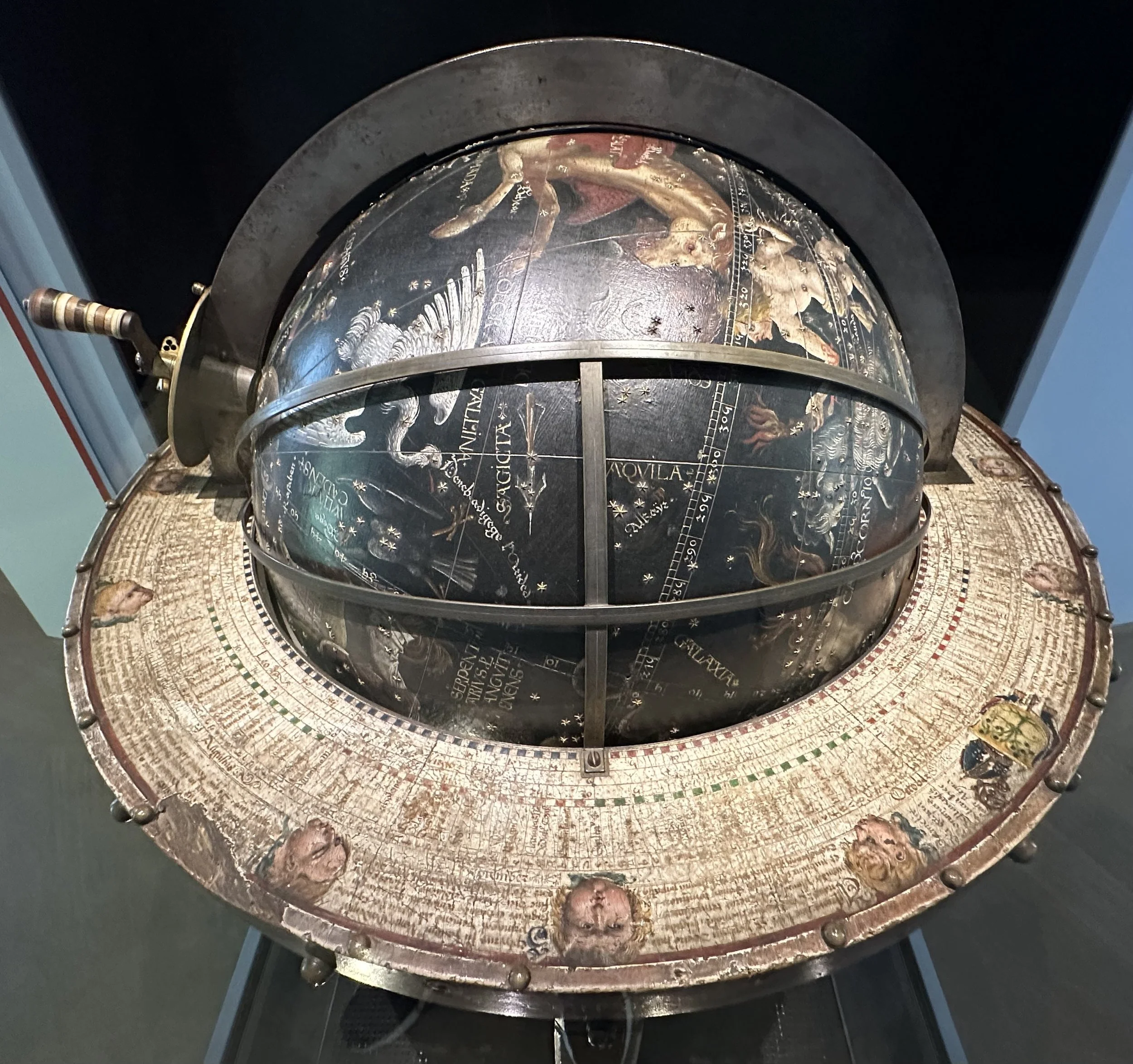Landesmuseum Württemberg Notes
Stuttgart, Germany
__________________________________________________________________________________
Hallstatt
The Hallstatt period marks the beginning of the Iron Age - which, as the name indicates, is characterized by a new material: iron. For the early Iron Age, however, we have no evidence of local iron production: presumably it had to be imported. In any case, though, there were significant changes in the metal supply chain, and control of this process now made other masters rich and powerful. The sword as a status symbol was replaced in the 7th century BC by the presentation dagger. This was a time when pomp in general became more and more important.
The Hallstatt period gets its name from the burial ground at Hallstatt in the Austrian region of Salzkammergut, which has been the subject of archaeological excavation since 1846. It is a continuation of the Late Bronze Age, initially without much change. For a long time, the new metal remained reserved for the upper classes and was used mainly for prestige purposes. Times seem to have become calmer, as is suggested by the abandonment of nearly all fortified hill settlements of the Late Bronze Age.
The Hallstatt culture marks the beginning of the triumphal progress of Iron through Central Europe. It was here that Late Bronze Age cultures evolved into the ethnic groups later referred to by the Greeks as ‘Celts’.
In the 5c BCE, there was a fundamental change in the cultural fabric of the Hallstatt period in eastern France and southwestern Germany. Most early Iron Age central places, the so-called »princely seats, lost their significance and were destroyed or abandoned between 450 and 400 BE. However, other areas further north that until then had played a sub- ordinate role now experienced a sudden upswing: the Marne and central Rhine region as well as Bohemia. At the same time, an entirely new art style with plant and circle decoration evolved in these regions and went on to adopt and adapt Mediterranean influences. This style became characteristic of the La Tène culture of the later Iron Age. The finds at the Kleinaspergle are perfect examples of the artistic style of this new age.
__________________________________________________________________________________
Celts
The Celts are first mentioned in the writings of Greek historians around 500 BCE. In archaeological terms, they are usually associated with the Late Iron Age (450-15 BCE) - the La Tène culture - but the roots of Celtic culture can already be found in the preceding Hallstatt culture (800-450 BCE)- for this period we speak of early Celts. From about 600 BCE, we find in southwestern Germany, eastern France and Switzerland fortified central places whose social elites favored sumptuous burials under earth mounds. This type of burial characterized early Celtic Central Europe for a period of nearly 200 years.
Oppida: Planned Celtic urban centers that were often extensively fortified and built at major road junctions, on hills or along rivers. In these towns, specialized craftsmen produced goods intended for broad distribution. Flourishing trade meant that markets had to be established; coins were used, and information was exchanged in (mostly Greek) writing.
Luxury goods were imported from the south, especially wine for the upper classes. Exports probably included non-perishable foodstuffs, textiles, raw materials and slaves. Safe water and land routes were an important prerequisite for such trade. As in Gaul, customs duties were probably levied here as well
Celtic and Germanic tribes equipped their dead with all the things they might need for the afterlife. This is why there are so many burial objects to be found in the northwest provinces.
__________________________________________________________________________________
Germanic
Many places names ending in -ngen, -heim, -statt, -stetten, and -dorf have their origins between the 3c and 5c.
__________________________________________________________________________________
Rome
The Roman army was organized in two main branches: the legions, which recruited their members among Roman citizens, and the auxiliaries (auxilia), where non-citizens served. After 25 years, soldiers in the auxiliaries were offered Roman citizenship in recognition of their services.
Legion (Roman): Consists of ~5,000 soldiers comprised of 10x Cohorts and 120 horsemen.
Cohort (Roman): Consists of 6x Centuriae.
Centuriae (Roman): Consists of ~80 soldiers
Cohortes Equitae (Roman): Mixed units that included horsemen.
In the late 2c, there were ~400K soldiers serving in the Roman army: 170,000 legionaries and 230,000 auxiliaries.
Provided the topography allowed it, forts were always built according to the same floor plan. A rectangular area was surrounded by a protective enclosure. Inside, the area was structured by two main streets that led from the gates to the centre of the fort, where the principia (HQ) were located. Next to HQ was the praetorium (the commander's residence) on one side and storage buildings on the other.
The soldiers' barracks, long blocks where eight men shared small rooms, were in the front and back parts of the camp; the officers lived in somewhat more spacious quarters at the end of each block.
Along the Upper German-Raetian Limes, forts were built every 8-10 km. The soldiers posted there were responsible for guard duty on the watchtowers and for patrols.
Trade in Roman times was very well organized. Goods could be transported to all parts of the Empire as well as beyond its borders. This extensive trade infrastructure also served the Limes territory. Transport by ship was significantly more economical than by land. Goods were first shipped from the areas where they were produced along the coastlines. The most important inland transport routes were the main rivers: the Rhine, the Rhone and the Danube…In Roman times, even the Neckar was used for shipping. Whenever transport by ship was not possible, loads were transferred to wagons. The excellent road network enabled the Romans to transport goods to nearly all corners of the Empire. The state charged levies and taxes on supraregional trade.
The Romans knew how to accurately measure time, and they had an exact calendar system. They counted the years according to the terms of office of their consuls or emperors. The system of counting years from the date of the foundation of Rome (ab urbe condita), 753 BC, was not regularly used until later antiquity. The year had twelve months that were named after gods or public personalities or according to their original position in the calendar, e.g., September from septimus / the seventh - until 153 BC, the Roman year began on 1 March. The days of the week were named after gods, for instance dies Luna (the day dedicated to. Luna / Monday). Three days of the month were particularly prominent: the first (Kalendae), the fifth or seventh (Nonae) and the 13th or 15th (Idus). The time of day could be determined exactly by means of sundials or water clocks. A difference was made between day hours and night hours.
The Roman population's staple food consisted of cereals processed into bread or porridge. The Roman diet also included fruit, vegetables, sausage products and cheese. Most meat came from cows or pigs. Imported goods such as olive oil, wine and fish sauces (garum/liquamen) rounded off whatever was available locally. In wealthy homes, oysters or purple snails might also be served…As evidenced by the great variety of cooking implements, food might be boiled, simmered, fried or grilled. Kitchens were rare in this part of the Empire; most houses and villas had simple fireplaces or stoves. There were also restaurants, eating houses, refreshment stalls and inns.
The Romans believed in the afterlife as a joyless existence in the form of a bloodless shadow. This is why only two burial objects were considered essential for the deceased: a coin to pay the ferryman and an oil lamp to light the darkness of the underworld…Cremation was the normal form of burial - were not permitted to be buried within the settlements, cemeteries were located along roads beyond the village or town boundaries. Honoring the dead was a sacred obligation; it was the only way to ensure that they did not return to the world of the living. There were special memorial days for the dead when graves were decorated and sacrificial offerings made.
The Romans believed in divine powers affecting all important phases of life. They believed that their various gods commanded special powers in specific domains. By the 3c BCE, twelve gods had emerged as the main deities of the Roman pantheon: Jupiter, Juno, Neptune, Minerva, Mars, Venus, Apollo, Diana, Mercury, Ceres, Vulcan and Vesta. But there were also scores of other gods as well as personified deities and tutelary spirits. The three supreme deities of the pantheon - the Capitoline Triad: Jupiter, Juno and Minerva - were worshipped in their main temple on Capitoline Hill in Rome as well as in the provinces. Their cult was based less on private motives than on the assumption that these three gods were essential for the continued existence of the Empire and hence for the personal environment of each of its inhabitants.
__________________________________________________________________________________
Alamanni
In the 3c, the Roman Empire is in the midst of a crisis. Starting in the year 233, Germanic tribes pose an ever-greater threat to the territory within the Limes. Military commanders are proclaimed Emperors by their troops, causing a state of virtual civil war. Worse still, an economic crisis is gnawing at the Empire from within. Needed in other parts of the Empire, soldiers are gradually withdrawn from the territory along the Upper German-Raetian Limes, so that efficient defence is no longer possible. Around the middle of the 3rd century, the population starts moving away, and by 274 at the latest, the military fortifications of the Limes are abandoned. In the years that follow, Germanic tribes begin settling on former Roman territory. Starting in 290, the new border along the Rhine. Danube and Iller rivers replaces the Limes.
Immediately after the Romans had given up the defence of the frontiers, Germanic tribes migrated into the region from the mid 3c- 5c. These small groups, which were organized in clans and came from a variety of areas, initially did not develop a great sense of togetherness. Over the course of time, however the diverse immigrant groups banded together in a new tribal confederation described in Roman sources Alamanni starting around the 4c. The land was not united and governed by a single family, however, but consisted of a number of dominions of petty kings that occasionally joined forces in raids against the Romans their Germanic neighbors.
The Christianization of the Alamanni took place over several centuries. As of the 6c, graves increasingly contained burial objects with Christian symbolism - a sign that the Alamanni were coming into contact with Christian thought more frequently. As the mixing of Christian and pagan symbolism shows, Christianity at first served them as a kind of supplementary religious insurance. The Alamanni held onto their custom of burial objects and continued to bury their dead in the old pagan burial grounds.
In the mid 8c, the Alamannic dukes make a fatal mistake: they let themselves be drawn into a conflict with the Frankish majordomos of the Carolingian dynasty. For nearly 100y, these officials, also referred to as mayors of the palace, had constituted the power behind the throne in the Frankish Empire, and in the 8c they moved to actually take hold of the crown.
By expanding their dominion, the Alamanni came into conflict with the Franks. The Frankish Merovingian king Clovis (r. 482-511) and his successors brought the Alamannic settlement areas under their control.
__________________________________________________________________________________
Merovingian (Franks)
Participating in wars and raids was an important way to increase a family's wealth, and thus raise its social status. Merovingian rulers did not have standing armies, however. In conflict situations, the nobility was able to draw on all able-bodied freemen, who, organized in retinues, were obliged to serve in the military. They were richly rewarded for their participation with valuable goods or land.
__________________________________________________________________________________
Carolingians
The winged lance symbolizes the military might of the new king. These weapons are found everywhere in the Carolingian kingdom.
__________________________________________________________________________________
Middle Ages
During the Middle Ages, many people made at least one pilgrimage during their lifetime to atone for their sins, or in the hope of shortening their time in purgatory. The journey, which was sometimes imposed as penance, offered people an opportunity to leave their limited home environments. Churches, hospitals and hostels were established for the crowds along the pilgrimage routes. The most important medieval places of pilgrimage were Jerusalem, Rome, Santiago de Compostela and Aachen. However, pilgrim destinations could also be found in southwestern Germany, such as Weingarten, where a relic containing the holy blood shed by Christ on the cross attracts believers to this very day. The pilgrims came home with devotional objects - religious souvenirs such as holy oil, miraculous healing waters and pilgrim badges said to ward off ill fortune.
__________________________________________________________________________________
Württemberg
The House of Württemberg is named after its ancestral castle, which was built in the late 11c: Württemberg Castle on the Rotenberg, near Untertürkheim. The end of the Hohenstaufen reign gave the Counts of Württemberg an opportunity to expand their territory. They accomplished this partly in conflicts with the German kings and the free imperial cities, but also through shrewd politics of marriage. For example, the later capital of Stuttgart and the county of Montbéliard, between Besançon and Belfort, came under Württemberg control as a result of marriages. The earliest recorded example of the crest with its three horizontal antlers dates back to 1228. The antlers have been in the Württemberg coat of arms without interruption since that time, and they can still be found on the greater coat of arms of Baden-Württemberg today.
Württemberg was a duchy from 1495 to 1803; it then became an electorate, and, in 1806, a kingdom. These three centuries were marked by far-reaching developments and events: the introduction of the Reformation, the Thirty Years' War, and the Enlightenment.
Territorial rulers and the councils of the imperial cities in the territory of modern Württemberg reacted quite differently to the ideas of the Reformation. In some territories and imperial cities, the Reformation was introduced swiftly and radically, while in others it was a longer process. Territorial rulers and municipal councils in the south of modern Württemberg, in Upper Swabia, remained Catholic. But there were also areas where the ruling princes had initially introduced the Reformation and then returned to Catholicism. For the imperial cities of Biberach and Ravensburg, a compromise was found in the Treaty of Westphalia (1648): all municipal bodies and authorities were filled with equal numbers of Catholics and Protestants.
Württemberg is one of the German regions whose inhabitants were most severely affected by the Thirty Years' War. The war caused a dramatic decline in population from which the duchy took years to recover. Hordes of soldiers roamed the country and mistreated its inhabitants. They looted food stores, triggering waves of famine. And then came the plague: plague epidemics raged in Württemberg in 1626, 1627 and 1635, claiming still more victims.
The Thirty Years' War (1618-1648), which brought widespread devastation to the duchy and its inhabitants, put an abrupt end to Württemberg's cultural blossoming. After the lost battles of Wimpfen and Nördlingen, the duchy was plundered and ravaged by Catholic troops. Duke Eberhard Ill fled into exile to Strasbourg. The war had also brought famine and epidemics, which in turn caused a drastic decline in population: while the duchy had had a pre-war population of 400,000, its residents in the 1650s numbered no more than 170,000. And even after the turmoil of the Thirty Years' War, Württemberg continued to experience troubled times: in the second half of the 17c, French troops invaded the duchy.
There were eighteen imperial cities in the territory of what would later become the Kingdom of Württemberg, independent political entities that were ruled by the emperor alone. Between 1802 and 1810, all imperial cities were dissolved and integrated into the kingdom. The powerful city councils were replaced by the Württemberg administrative authorities. Some of the imperial cities were also centers of considerable political, economic and cultural importance, for instance Ulm, which around 1800 had an area of roughly 1,250 sqkm and a population of ~50,000. The upheaval was particularly severe for the free imperial city of Buchhorn on Lake Constance, which lost not only its independence but also its name. King Friedrich merged Buchhorn and the dissolved monastery of Hofen into a town to which he gave a new name – his own: Friedrichshafen!
After the victorious war against France, the German Empire is proclaimed in 1871. Prussia holds a dominant position in the Empire - a fact not without consequences for the Kingdom of Württemberg. Major powers must now be relinquished, as many decisions are now taken in Berlin. The influence of the King of Württemberg shrinks, while on the other hand Prussia's influence on life and politics in Württemberg increases, particularly in the military area.
__________________________________________________________________________________
Chronology
1952: The new state of Baden-Württemberg is established in SW Germany (Landesmuseum Württemberg).
Nov, 1918: Establishment of the Weimar Republic; Württemberg King Wilhelm II abdicates power and the free people’s state of Württemberg becomes one of its constituent states (Landesmuseum Württemberg).
1891- 1921: Reign of Wilhelm II (1848-1921) as 4th and last King of Württemberg. As Karl had no children, succession passed to his cousin's son Wilhelm II, who ruled from 1891 until his abdication in 1918 (Landesmuseum Württemberg).
1883: Policy-makers under German chancellor Bismarck begin addressing social destitution by passing social security legislation. Positive examples were provided by entrepreneurs who built housing estates for their workers or founded pension funds and health insurance schemes. There was, of course, a certain measure of self-interest in their commitment, as better social security also meant that employees grew more dependent on their employers (Landesmuseum Württemberg).
1864-1891: Reign of Karl (1823-1891) as 3rd King of Württemberg on the death of his father (Landesmuseum Württemberg).
1816-1864: Reign of Wilhelm I (1781-1864) as 2nd King of Württemberg on the death of his father (Landesmuseum Württemberg).
1806: Dissolution of the Holy Roman Empire. Under Napoleon, the many small ecclesiastical and secular domains in SW Germany are dissolved, leaving only Württemberg, Baden, and Hohenzollern. Württemberg becomes an independent kingdom and sees its area nearly double in size, despite ceding its territories West of the Rhine to France (Landesmuseum Württemberg).
1802-1810: The 18 Imperial Cities that make up Württemberg are dissolved and integrated into Kingdom of Württemberg (Landesmuseum Württemberg).
1797-1816: Reign of Friedreich I (1754-1816) as Duke of Württemberg; in 1803 he became prince-elector and from 1806 onward he was Württemberg's first king (Landesmuseum Württemberg).
1688-1692: Palatine War of Succession; French forces led by Général Mélac invade Württemberg and SW Germany (Landesmuseum Württemberg).
1677-1733: Reign of Eberhard Ludwig as Duke of Württemberg. Following the early death of his father, Wilhelm, Eberhard becomes Duke at the age of 1. Until he is declared ‘of age’ at 16 (in 1693), he is placed under the guardianship of his mother Magdalena Sibylla von Hessen-Darmstadt and his uncle Friedrich Carl von Württemberg-Winnental. On assuming power, Eberhard introduces a baroque lifestyle emulating French models and has a spacious palace built at Ludwigsburg, which he moves into in 1724 (Landesmuseum Württemberg).
1674-1677: Reign of Wilhelm Ludwig as Duke of Württemberg (Landesmuseum Württemberg).
1649: Expansion of compulsory schooling In Württemberg to all children <14 yo. School attendance is more strictly controlled, and, over time, the system is expanded to cover the entire territory of the duchy (Landesmuseum Württemberg).
1648: The Treaty of Westphalia; all municipal bodies and authorities are to be filled with equal numbers of Catholics and Protestants (Landesmuseum Württemberg).
1642: Introduction of morality courts in the Duchy of Württemberg; established by theologian and mathematician Johann Valentin Andreae and meant to monitor the moral behavior of the population. These courts continue to exist until 1891. Whenever someone is reported to the court and fined for a moral lapse, the informer is rewarded with one third of the amount of the fine (Landesmuseum Württemberg).
1635: Plague ravages Germany including Württemberg (Landesmuseum Württemberg).
1629: Enactment of the Edict of Restitution by Emperor Ferdinand II (r. 1619-1637) at the peak of Catholic power during the Thirty Years' War: all church property secularized and expropriated by Protestant princes after 1552 is now to be restored to Catholic possession. As a result of the Edict, the Duchy of Württemberg loses about one third of its territory (Landesmuseum Württemberg).
1628-1674: Reign of Eberhard Ill as Duke of Württemberg (Landesmuseum Württemberg).
1626-1627: Plague ravages Germany including Württemberg (Landesmuseum Württemberg).
1618-1648: The Thirty Years' War brings widespread devastation to Central Europe (Landesmuseum Württemberg).
1634-1648: Hohentwiel fortress holds out against all enemy attacks In the Thirty Years' War, the only Württemberg fortresses to do so (Landesmuseum Württemberg).
6 Sep, 1634: The Battle of Nördlingen; Protestant troops suffer a crushing defeat. The Duke of Württemberg is forced to flee into exile, and enemy soldiers roam the country, killing and plundering as they go (Landesmuseum Württemberg).
1611-1618: Ellwangen Monastery Witch trials; many people are accused of witchcraft and prosecuted. ~430 people, 80% women, confess under torture and are put to death (Landesmuseum Württemberg).
1609: Publication of “Astronomia Nova” by Johannes Kepler, in which he formulates two laws on planetary orbits. His first law states that the orbit of every planet is an ellipse with the Sun at one of the two foci; the second, that a line joining a planet and the Sun sweeps out equal areas during equal intervals of time. Kepler's results were based on the heliocentric cosmology postulated by Nicolas Copernicus (1473-1543), which assumed that the Sun was at the centre of the universe with the Earth circling around it, as well as on his own meticulous observation of celestial bodies (Landesmuseum Württemberg).
1608: Foundation of the Protestant Union as imperial cities join forces. Its members include Johann Friedrich, Duke of Württemberg (r. 1608-1628) as well as representatives of the imperial cities of Aalen, Esslingen, Giengen, Hall, Heilbronn and Ulm (Landesmuseum Württemberg).
1608-1628: Reign of Johann Friedrich as Duke of Württemberg (Landesmuseum Württemberg).
1603: The capital city of the Japanese Empire is transferred from Kyoto to Edo (now Tokyo) (Landesmuseum Württemberg).
1557: China authorizes Portuguese traders to build a settlement in Macao (Landesmuseum Württemberg).
1552: The expanding Russian empire conquers Kazan, the capital of the Volga Tatars. It serves as the starting point for further advances towards the economically important region of Siberia (Landesmuseum Württemberg).
31 Oct, 1517: Martin Luther publishes his 95 Theses- a sharp criticism of the selling of indulgences and other practices of the Catholic Church. While Luther is outlawed by the Pope and the Emperor on charges of heresy, his ideas find favour in broad segments of the population. In printed form, the 95 Theses soon spread across Germany. Luther becomes the quintessential symbol of the new faith (Landesmuseum Württemberg).
16c: Timbuktu develops into the cultural and intellectual center of the Songhai Empire in W. Africa. Timbuktu University teaches Arabic, Law, Rhetoric, Astrology, Medicine, and Koranic exegesis. Timbuktu’s conquest by Morocco in 1591 marked the beginning of the city’s decline (Landesmuseum Württemberg).
1495: The Diet of Worms; Maximilian I raises the counts of Württemberg to ducal rank (Landesmuseum Württemberg).
1438-1471: Reign of Pachacutec Yupanqui over the Incan Empire (Landesmuseum Württemberg).
1407: The county of Mömpelgard falls to Württemberg as a result of a clever marriage between Count Eberhard IV of Württemberg (r. 1417-1419) with Henriette von Montbéliard-Montfaucon (1384/1391-1444). At first, he rules only Mömpelgard, but after the death of his childless uncle, he takes over rule in Stuttgart (Landesmuseum Württemberg).
Mid 14c- End 16c: The Great Wall, China’s bulwark against external threats, is repaired and extended. The mighty structure stretches over ~9000km. It is ~8m high and up to 3.5m wide across the top, so that its crown can also be used as a road (Landesmuseum Württemberg).
1300: The Ottoman Empire develops in Asia Minor and expands swiftly through vast areas that had previously been part of the Byzantine Empire. By the end of the 14c, the Ottomans had already reached the walls of Belgrade in the Balkans (Landesmuseum Württemberg).
1153: The Schöntal monastery is founded by Cistercian monks (Landesmuseum Württemberg).
1138: The Maulbronn monastery is founded by Cistercian monks (Landesmuseum Württemberg).
1102: The Hohenstaufen monastery is founded in Lorch by Benedictine Monks (Landesmuseum Württemberg).
Late 11c: Construction of the Castle Württemberg, for which the House of Württemberg is named (Landesmuseum Württemberg).
1076: The Muslim Berber armies of the Almoravids destroy the 500y old Ghana Empire along the Upper Niger and the Senegal Rivers, on the territory of what is now Mali (Landesmuseum Württemberg).
1056: The Welfen monastery is founded in Weingarten by Benedictine Monks (Landesmuseum Württemberg).
978-1015: Reign of Rus Grand Duke Vladimir, who leads the Christianization of the Rus (Landesmuseum Württemberg).
911: Oleg the Wise concludes an advantageous trade agreement with Constantinople, which regulates commercial relations between the two states and lays the basis for the development of permanent and lucrative trade between Constantinople and Kievan Rus (Britannica).
907: Oleg the Wise undertakes an expedition against Constantinople, forcing the Byzantine government to sue for peace and pay a large indemnity (Britannica).
882: Oleg the Wise sails down the Dnieper River with his Varangian retinue and seizes control of Smolensk and Kiev, which he makes his capital, extending his authority E and W of the Volkhov-Dnieper waterway. He unites the local Slavic and Finnish tribes under his rule and became the undisputed ruler of the Kievan-Novgorodian state (Britannica).
879: Oleg the Wise (‘Oleg of Kiev’) succeeds his kinsman Rurik as ruler of Novgorod (Britannica).
879: Last documented date of the Mayan city of Tikal (Landesmuseum Württemberg).
822: Last documented date of the Mayan city of Copan (Landesmuseum Württemberg).
799: Last documented date of the Mayan city of Palenque (Landesmuseum Württemberg).
794: The capital city of the Japanese Empire is transferred from Nara to Heian-Kyo (now Kyoto) (Landesmuseum Württemberg).
8 Jun, 793: The Vikings attack Lindisfarne Priory; the Vikings age begins (Landesmuseum Württemberg).
764: Ellwangen monastery is founded during the Carolingian period, the oldest in Württemberg (Landesmuseum Württemberg).
746: The Council of Cannstatt (‘The Blood Court at Cannstatt’); the mayor of the palace of Austrasia and Carloman, the eldest son of Charles Martel, extends an invitation to the nobles of Alemanni. On arrival, Carloman arrests several thousand noblemen, accuses them of taking part in the uprising of Theudebald, Duke of Alamannia and Odilo, Duke of Bavaria, and summarily executes them all for high treason, virtually eliminating the entire tribal leadership of the Alemanni and ending the independence of the duchy of Alamannia, after which it was ruled by Frankish Dukes (Wiki).
746: Alamannic nobles rise up against the ambitious Carolingian chamberlains hoping to restore their lands (Landesmuseum Württemberg).
636: The Battle of Yarmouk River (modern Syria-Jordan border); Arab forces decisively defeat a Byzantine Army led by Byzantine Emperor Heraclius (r 610-641). In the years that follow, the East Roman Levantine provinces, Syria and Egypt, become Arab (Landesmuseum Württemberg).
15 Jun, 622: Mohammed flees Mecca for Medina, marking the beginning of the Islamic Calendar (Landesmuseum Württemberg).
618-900: China is ruled by the T’ang Empire. During this period, it expands westwards along the Silk Road, and opens up to trade and interaction with its western neighbors. The invention of printing and gunpowder take place during the T’ang dynasty (Landesmuseum Württemberg).
610-641: Reign of Byzantine Emperor Heraclius (Landesmuseum Württemberg).
600: Collapse of the Aksumite Empire (Ethiopia). The kingdom, which had been Christian since the 4c, had developed along the Eastern Red Sea coast of Ethiopia (Landesmuseum Württemberg).
600: The Old High German language is established (from which modern German derives) (Landesmuseum Württemberg).
584-591: Frankish King Childebert II wages Italian Campaigns (Landesmuseum Württemberg).
570-596: Reign of Merovingian King Childebert II (Landesmuseum Württemberg).
536/537: Alamannia falls to the Franks after Vitiges, one of Ostrogoth King Theodoric successor’s, hands them over to the Franks, who establish the Southern area as the Frankish duchy of Alamannia (Landesmuseum Württemberg).
511: Death of Frankish King Clovis I (Landesmuseum Württemberg).
506: The Alamanni suffer a final defeat at the hands of Clovis I, losing their entire northern territory as a result (Landesmuseum Württemberg).
496: The Battle of Tolbiac; Frankish King Clovis I defeats an Alamannic force, establishing his hegemony over the N. part of the Alamannic territory while the southern part comes under the protection of Theodoric, the Great king of the Ostrogoths (Landesmuseum Württemberg).
482-511: Reign of Frankish Merovingian King Clovis (Landesmuseum Württemberg).
401: The last Roman bastion in Württemberg at Vemania is abandoned because the border troops are recalled to fight the Visigoths (Landesmuseum Württemberg).
380: Christianity is raised to the status of Roman state religion (Landesmuseum Württemberg).
4c: Rise of the Alamanni in Central Europe as a number of dominions of petty kings that occasionally join forces in raids against the Romans and their Germanic neighbors (Landesmuseum Württemberg).
313: The Edict of Milan; Roman emperors Constantine and Licinius guarantee freedom of religion to Christians in the Roman empire (Landesmuseum Württemberg).
300: The first Germanic population groups settle in Raetia, North of the Danube (Landesmuseum Württemberg).
290: The Romans establish the Danube-Iller Limes as a northern ‘wet border’ along the Rhine, Danube, and Iller Rivers that replaces the Limes (Landesmuseum Württemberg).
283: Roman Co-Emperor Carinus fends off Germanic intrusions in upper Germania and Raetia (Landesmuseum Württemberg).
278: Roman Emperor Probus defeats the Burgundians and the Vandals in Raetia (Landesmuseum Württemberg).
277: Roman Emperor Probus pushes Germanic tribes back behind the Rhine (Landesmuseum Württemberg).
~275: Lactantius (250-325), a rhetorician, church scholar, and apologist of the Christian faith, becomes the first to reject the already proven idea that the earth is round. He believes that if this were the case, people on the underside of the earth (the Antipodes) would be standing on their heads and that rain would fall upwards (Landesmuseum Württemberg).
274: Roman forces abandon the Limes fortifications (Landesmuseum Württemberg).
274: The breakaway Gallic Empire is reunited with Rome (Landesmuseum Württemberg).
270-280: Germanic settlers begin moving into Limes territory (Landesmuseum Württemberg).
270: Roman emperor Aurelian defeats the Germanic Juthungi tribe in Raetia and Upper Germania (Landesmuseum Württemberg).
265: Roman Emperor Gallienus reconquers Raetia (Landesmuseum Württemberg).
3c: Construction of Xunantunich by the Maya during their classic period (200-900) (Landesmuseum Württemberg).
260: The Battle of Edessa; Persian forces led by Shapur I defeat Roman forces under Emperor Valerian (r. 253-260) near Edessa, taking the emperor prisoner for the first time in Roman history (Landesmuseum Württemberg, Wiki).
260: A Roman citizens militia in Gaul led by Postumus, defeats Germanic tribes near Augsburg. Postumus is declared emperor of the breakaway Gallic Empire (Landesmuseum Württemberg).
259: Germanic tribes march across the Limes hinterland towards Gaul, Spain, and Upper Italy, looting and vandalizing as they advance (Landesmuseum Württemberg).
254: Germanic tribes invade Raetia, now largely defenseless. They destroy most of the forts along the Limes and plunder rural estates in the hinterland. As a result, the Romans abandon Raetia north of the Danube (Landesmuseum Württemberg).
253: Roman Emperor Valerian withdraws troops from the Raetian Limes (Landesmuseum Württemberg).
240-272: Reign of Shapur I as King of the Persian Sassanid Empire (Landesmuseum Württemberg).
235: Roman Emperor Severus Alexander is murdered in Mainz. His successor Emperor Maximus Thrax conducts an offensive against the Germanic tribes, securing the Limes, and refortifying destroyed forts (Landesmuseum Württemberg).
233: Germanic tribes attack parts of Upper Germania, plundering and destroying numerous Roman settlements and forts within the Limes (Landesmuseum Württemberg).
224: Foundation of the Persian Sassanid Empire, a power that will become a fierce enemy of the Romans in the East (Landesmuseum Württemberg).
220-280: After the end of the Han Dynasty, China is divided in three competing kingdoms; Wei, Wu, and Shu Han. None of these kingdoms manages to gain supremacy. The period of the three kingdoms does not come to an end until Emperor Wu of Jin (265-290) establishes the Jin dynasty (Landesmuseum Württemberg).
213: Roman Emperor Caracalla launches a military campaign into unoccupied Germanic territory (Landesmuseum Württemberg).
200: The Romans complete fortifications of the Upper German-Raetian Limes, protecting it with ramparts and trenches in Upper Germania and with a wall in Raetia. The Limes reach their maximum extension in SW Germany (Landesmuseum Württemberg).
~160: The Romans push their northern border E and N. This new border, known as the Upper German-Raetian Limes, remained unchanged until the withdrawal of the Romans in the 3c (Landesmuseum Württemberg).
121: The First Chinese dictionary is published (Landesmuseum Württemberg).
105: Paper is invented in Han China (Landesmuseum Württemberg).
~85: The Romans establish the provinces of Upper and Lower Germania and began fortifying the border along the Swabian jura, in the Neckar valley, and in the Odenwald and Wetterau regions around 100 AD (Landesmuseum Württemberg).
83-85: The Romans wage war against the Germanic Chatti tribe (Landesmuseum Württemberg).
73: Roman Emperor Vespasian sends troops to occupy additional territories in SW Germany. They build Kinzig valley road, bringing further parts of SW Germany under their control (Landesmuseum Württemberg).
69: Year of the Four Roman Emperors and revolt of the Batavi in the Lower Rhine Region (Landesmuseum Württemberg).
1c: Construction of the Teotihuacan Pyramid of the Sun, which rises on an area of 225x225m and 65m height (Landesmuseum Württemberg).
1c: Rise of the Moche (‘Mochica’) culture in N. Peru. Its trademarks are highly skilled crafts and metalworking (Landesmuseum Württemberg).
~45: Roman forces fortify the line formed by the Danube west of the river Iller, building forts and improving roads along the Danube (Landesmuseum Württemberg).
~15: Raetia becomes a Roman province (Landesmuseum Württemberg).
2: The first known recorded census in history takes place in Han China (Landesmuseum Württemberg).
12 BCE: The Romans campaign against Germanic tribes, advancing into the Alpine foothills in S. Germany and towards Lake Constance (Landesmuseum Württemberg).
15 BCE: Emperor Augustus’s military campaign in the Alps gives the Romans control of the Alpine foothills. The Romans build their first military base in Baden-Württemberg at Dangstetten. However, this castrum is abandoned only a short time later (Landesmuseum Württemberg).
Late 1c BCE: A second wave of Germanic migrants from Thuringia reach the Mainfranken region and the valley of the Tauber. The Celtic- Germanic mix is now dominated by the Germanic element, setting the stage for the Celts to slowly make their exit and for the Germans to take centre stage (Landesmuseum Württemberg).
71 BCE: Suebian King Ariovistus and his 15K Germanic warriors cross the Rhine from Gaul (Landesmuseum Württemberg), assisting the Arverni and Sequani in defeating their rivals, the Aedui. They settle in large numbers into conquered Gallic territory, in the Alsace region (Wiki).
100-50 BCE: Germanic settlers from the east gradually move south into Central Europe while the Celtic population withdraws. Traces of E. Germanic settlements interspersed with Celtic traces in the valley of the Tauber would seem to indicate predominantly unwarlike coexistence (Landesmuseum Württemberg).
200 BCE- 600: Nazca culture in Peru (Landesmuseum Württemberg).
3c BCE: 12 Gods emerged as the main deities of the Roman pantheon: Jupiter, Juno, Neptune, Minerva, Mars, Venus, Apollo, Diana, Mercury, Ceres, Vulcan and Vesta (Landesmuseum Württemberg).
278 BCE: Several Celtic tribes come to Asia Minor as mercenaries. They settle in the area around Ankara and become known as the Galatians (Landesmuseum Württemberg).
279 BCE: Celtic armies attempt to plunder the Greek temple at Delphi but fail, supposedly because the God’s intervene (Landesmuseum Württemberg).
323 BCE: Death of Alexander the Great in Babylon (Landesmuseum Württemberg).
330 BCE: The Conquest of Persepolis; Alexander the Great is said to have used 10K mules and 5K camels to transport the rich booty he carries back from his conquest of Persepolis (Landesmuseum Württemberg).
387 BCE: Vae Victus- Woe to the Vanquished! Rome falls to the Celts (Landesmuseum Württemberg).
~400 BCE: Celtic tribes spread across Europe, occupying large parts of upper Italy and continuing down the Danube as far as Greece and Asia Minor. Celtic art, culture and language - apparently not accompanied by migration in Significant numbers - also reached Britain and Ireland, whose inhabitants were not considered Celtic in ancient times (Landesmuseum Württemberg).
450 BCE: End of the Hallstatt culture period in SW Germany (Landesmuseum Württemberg).
450 BCE: The Western Hallstatt culture evolves into the Celtic La Tène culture (from the site of the finds, La Tène on Lake Neuchâtel in Switzerland). Celtic culture gradually spreads across large parts of Europe (Landesmuseum Württemberg).
500 BCE: The term ‘Celts’ is first mentioned in the writings of Greek historians; Herodotus writes: “For the Istros (Danube) has its source among the Celts, near the town of Pyrene, and flows across the center of Europe.” Pyrene may be a reference to Heuneburg, the town-like settlement along the Danube (Landesmuseum Württemberg).
550 BCE: Iron ore is mined, processed, and smelted in the area of Neuenbürg in the Black Forest, the oldest known ironworks N of the Alps. Around this time, a fortified settlement is established on the Schlossberg at Neuenbürg (Landesmuseum Württemberg).
600 BCE: The Greek establish the colony of Massilia on today’s Med France (Landesmuseum Württemberg).
600 BCE: SW Germany sees the establishment of fortified central settlements (Landesmuseum Württemberg).
650-600 BCE: Hallstatt culture burial rites begin to change with the dead being buried without cremation and laid to rest with grave offerings such as jewelry and weapons (Landesmuseum Württemberg).
~7c BCE: The Scythians, a horse-riding nomadic people, settle in the area between the Eurasian steppe and the Black Sea (Landesmuseum Württemberg).
669-631/627 BCE: Reign of King Ashurbanipal over the Neo-Assyrian Empire at Nineveh (Landesmuseum Württemberg).
700 BCE: Hallstatt Culture gradually develops into the E. and W. Hallstatt cultures (Landesmuseum Württemberg).
800-200 BCE: Paracas culture in Peru (Landesmuseum Württemberg).
800-450 BCE: The Late Bronze Age urnfield culture gradually evolves into the Hallstatt culture, marking the onset of the iron age. Hallstatt is named for the Hallstatt burial grounds. Two trademark features of Hallstatt are the use of Fe and the construction of burial mounds in which the dead are buried after being cremated on funeral pyres (Landesmuseum Württemberg).
1300 BCE: Invention of 4-wheeled wagons pulled by two horses in Central Europe (Landesmuseum Württemberg).
1500 BCE: The Olmec flourish as the first advanced civilization in Mesoamerica (La Venta culture). Olmec sites include La Venta and San Lorenzo Tenochtitlan along the Gulf of Mexico (Landesmuseum Württemberg).
1550-1070 BCE: Thebes is the capital and cultural center of Egypt’s New Kingdom Period, for which the Karnak temple complex and the Valley of the Kings are among its most outstanding monuments (Landesmuseum Württemberg).
2000 BCE: The Minoans build a large palace complex with impressive murals at Knossos, Phaistos, and Malia on the island of Crete. The Minoans were skilled seafarers with a network of trade relations that extended all the way to Egypt (Landesmuseum Württemberg).
2700-2400 BCE: The Corded Pottery culture spreads across vast parts of central and eastern Europe, once again uniting large areas of the continent into a collective cultural space. West of this population group was the Bell Beaker culture. Corded Pottery burial sites show observance of strict burial rites, with the dead laid to rest on their left or right sides depending on gender, and aligned in a W-E direction (Landesmuseum Württemberg).
2800-1000 BCE: The Sanxingdui culture of Sichuan province, China (Landesmuseum Württemberg).
4500 BCE: Collapse of the Linear Pottery culture. Following it, small or more wide-ranging cultures alternated in rapid succession in the loess areas. They continued to be strongly related to the Danubian tradition in their way of life, building styles and burial customs (Landesmuseum Württemberg).
4600-4400 BCE: Rössen culture spreads in Central Europe (Landesmuseum Württemberg).
6m BCE: Dating of the oldest known irrigation canals in Choga Mami, an agricultural settlement in the low hills NW of Bagdad (Landesmuseum Württemberg).
5500-4500 BCE: Linear Pottery Culture flourishes around Europe. Most cultural evidence has been found on the middle Danube, the upper and middle Elbe, and the upper and middle Rhine. The pottery consists of simple cups, bowls, vases, jugs without handles and, in a later phase, with pierced lugs, bases, and necks (Wiki).
5600 BCE: In SW Germany, the transition from game hunting to farming takes place; sheep, goats, cattle and pigs are now being bred as domestic animals, and cereals grew in the fields (Landesmuseum Württemberg).
7500 BCE: Evolution of farming culture in China (Landesmuseum Württemberg).
10m BCE: People in the middle east are growing emmer, single-corn wheat and barley and domesticating the wild ancestors of European sheep and goats. Initially, cattle were kept as a continuous reserve of meat; later on, wool and milk production took on growing importance. Early farmers had to process cows' milk so that they could drink it; later on, their descendants developed an enzyme that allowed adults to digest larger quantities of milk (Landesmuseum Württemberg).
16-12 Ka: Europe’s Magdalenian Period; Reindeer and horse hunters reach the edge of N. Europe. Conditions for human and animal survival in the thinly wooded tundra improve; the ice sheet starts to melt. Sparse woodlands begin appearing along the Danube. Deer, roe deer, aurochs, wisent and wolves roam the landscape, their presence clear evidence of a warmer climate (Landesmuseum Württemberg).
18 Ka: Central Europe is slowly resettled by humans migrating from the W (Landesmuseum Württemberg).
20 Ka: The Second Glacial Maximum; peak of the ice age; the region N. of the Alps remains virtually unpopulated for an entire millennium (Landesmuseum Württemberg).
29-21 Ka: Europe’s Gravettian Period; named for the French site of La Gravette. During this period, the rather inhospitable climate of the Swabian Jura seems to have allowed no more than sporadic settlement. In these dry and cold times, the region was dominated by steppe and tundra landscapes covered with little more than grasses and herbs. Only a few robust tree species like pines, birches and willows managed to grow in well-protected spots. In the cold and dry conditions, the sparsely wooded steppe with roaming herds of mammoths gradually became a tree- less tundra grazed by wild horses and reindeer. And as Alpine glaciers advanced further and further south in these climatic conditions, the region ultimately became uninhabitable for millennia (Landesmuseum Württemberg).
40-30 Ka: Europe’s Aurignacian period; named for a French site at Aurignac (Haute-Garonne), it begins with the appearance of the first modern humans in Europe. The Aurignac culture was known for its outstanding small-size works of art and occurred during a time of rapidly alternating climate extremes (Landesmuseum Württemberg).
__________________________________________________________________________________

